Financial Accounting - Taj Accountants
VerifiedAdded on 2021/02/21
|34
|5329
|41
AI Summary
Contribute Materials
Your contribution can guide someone’s learning journey. Share your
documents today.
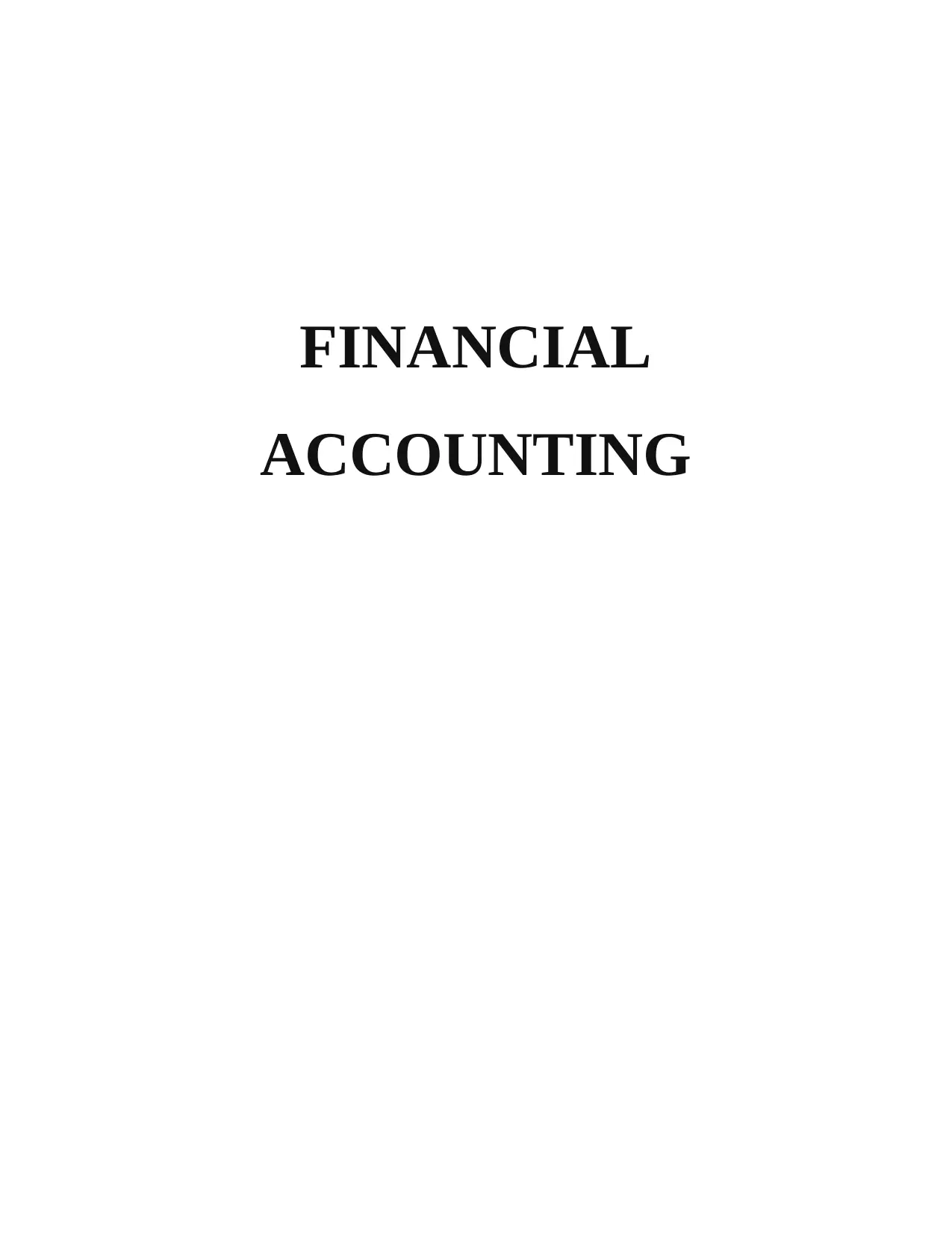
FINANCIAL
ACCOUNTING
ACCOUNTING
Secure Best Marks with AI Grader
Need help grading? Try our AI Grader for instant feedback on your assignments.
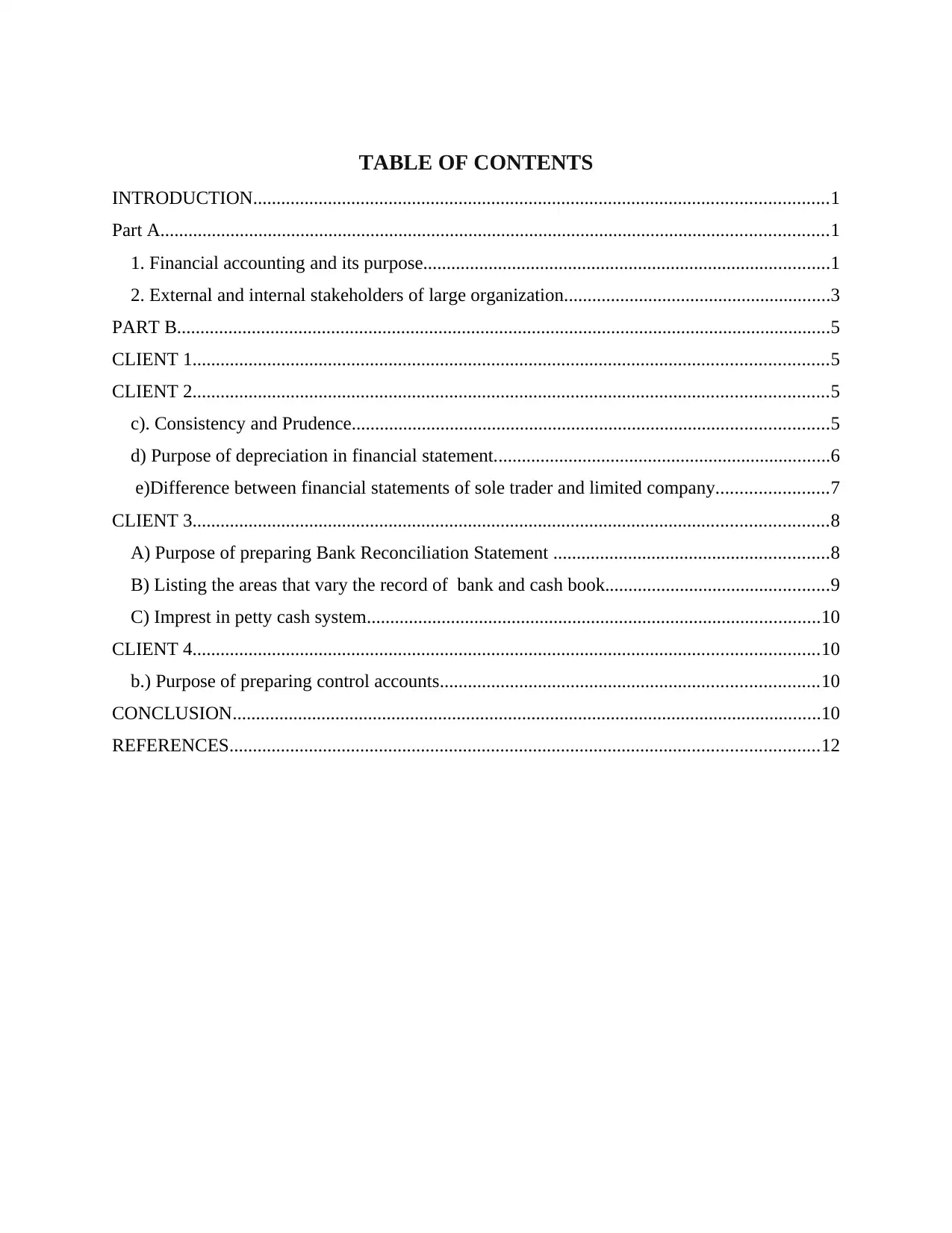
TABLE OF CONTENTS
INTRODUCTION...........................................................................................................................1
Part A...............................................................................................................................................1
1. Financial accounting and its purpose.......................................................................................1
2. External and internal stakeholders of large organization.........................................................3
PART B............................................................................................................................................5
CLIENT 1........................................................................................................................................5
CLIENT 2........................................................................................................................................5
c). Consistency and Prudence......................................................................................................5
d) Purpose of depreciation in financial statement........................................................................6
e)Difference between financial statements of sole trader and limited company........................7
CLIENT 3........................................................................................................................................8
A) Purpose of preparing Bank Reconciliation Statement ...........................................................8
B) Listing the areas that vary the record of bank and cash book................................................9
C) Imprest in petty cash system.................................................................................................10
CLIENT 4......................................................................................................................................10
b.) Purpose of preparing control accounts.................................................................................10
CONCLUSION..............................................................................................................................10
REFERENCES..............................................................................................................................12
INTRODUCTION...........................................................................................................................1
Part A...............................................................................................................................................1
1. Financial accounting and its purpose.......................................................................................1
2. External and internal stakeholders of large organization.........................................................3
PART B............................................................................................................................................5
CLIENT 1........................................................................................................................................5
CLIENT 2........................................................................................................................................5
c). Consistency and Prudence......................................................................................................5
d) Purpose of depreciation in financial statement........................................................................6
e)Difference between financial statements of sole trader and limited company........................7
CLIENT 3........................................................................................................................................8
A) Purpose of preparing Bank Reconciliation Statement ...........................................................8
B) Listing the areas that vary the record of bank and cash book................................................9
C) Imprest in petty cash system.................................................................................................10
CLIENT 4......................................................................................................................................10
b.) Purpose of preparing control accounts.................................................................................10
CONCLUSION..............................................................................................................................10
REFERENCES..............................................................................................................................12
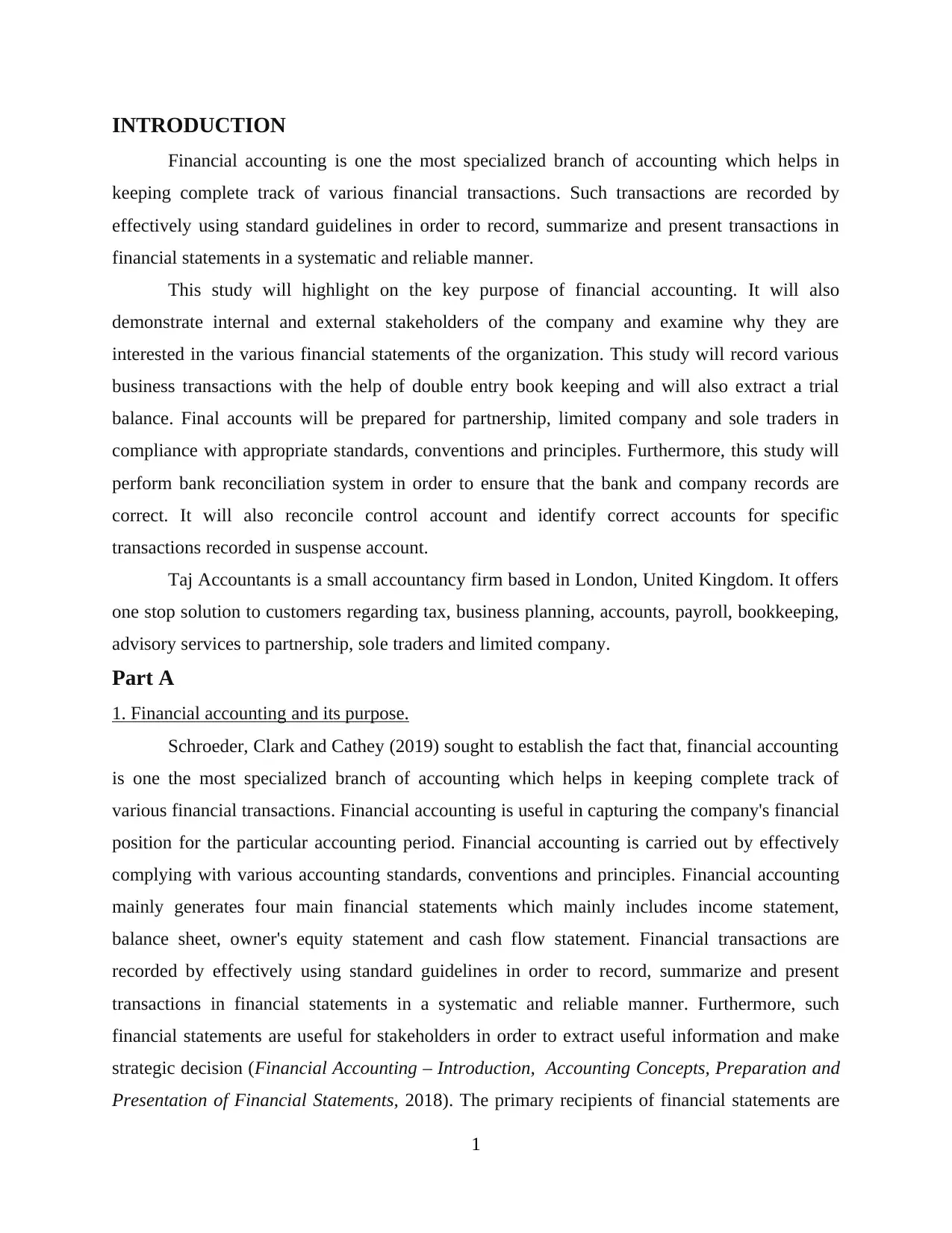
INTRODUCTION
Financial accounting is one the most specialized branch of accounting which helps in
keeping complete track of various financial transactions. Such transactions are recorded by
effectively using standard guidelines in order to record, summarize and present transactions in
financial statements in a systematic and reliable manner.
This study will highlight on the key purpose of financial accounting. It will also
demonstrate internal and external stakeholders of the company and examine why they are
interested in the various financial statements of the organization. This study will record various
business transactions with the help of double entry book keeping and will also extract a trial
balance. Final accounts will be prepared for partnership, limited company and sole traders in
compliance with appropriate standards, conventions and principles. Furthermore, this study will
perform bank reconciliation system in order to ensure that the bank and company records are
correct. It will also reconcile control account and identify correct accounts for specific
transactions recorded in suspense account.
Taj Accountants is a small accountancy firm based in London, United Kingdom. It offers
one stop solution to customers regarding tax, business planning, accounts, payroll, bookkeeping,
advisory services to partnership, sole traders and limited company.
Part A
1. Financial accounting and its purpose.
Schroeder, Clark and Cathey (2019) sought to establish the fact that, financial accounting
is one the most specialized branch of accounting which helps in keeping complete track of
various financial transactions. Financial accounting is useful in capturing the company's financial
position for the particular accounting period. Financial accounting is carried out by effectively
complying with various accounting standards, conventions and principles. Financial accounting
mainly generates four main financial statements which mainly includes income statement,
balance sheet, owner's equity statement and cash flow statement. Financial transactions are
recorded by effectively using standard guidelines in order to record, summarize and present
transactions in financial statements in a systematic and reliable manner. Furthermore, such
financial statements are useful for stakeholders in order to extract useful information and make
strategic decision (Financial Accounting – Introduction, Accounting Concepts, Preparation and
Presentation of Financial Statements, 2018). The primary recipients of financial statements are
1
Financial accounting is one the most specialized branch of accounting which helps in
keeping complete track of various financial transactions. Such transactions are recorded by
effectively using standard guidelines in order to record, summarize and present transactions in
financial statements in a systematic and reliable manner.
This study will highlight on the key purpose of financial accounting. It will also
demonstrate internal and external stakeholders of the company and examine why they are
interested in the various financial statements of the organization. This study will record various
business transactions with the help of double entry book keeping and will also extract a trial
balance. Final accounts will be prepared for partnership, limited company and sole traders in
compliance with appropriate standards, conventions and principles. Furthermore, this study will
perform bank reconciliation system in order to ensure that the bank and company records are
correct. It will also reconcile control account and identify correct accounts for specific
transactions recorded in suspense account.
Taj Accountants is a small accountancy firm based in London, United Kingdom. It offers
one stop solution to customers regarding tax, business planning, accounts, payroll, bookkeeping,
advisory services to partnership, sole traders and limited company.
Part A
1. Financial accounting and its purpose.
Schroeder, Clark and Cathey (2019) sought to establish the fact that, financial accounting
is one the most specialized branch of accounting which helps in keeping complete track of
various financial transactions. Financial accounting is useful in capturing the company's financial
position for the particular accounting period. Financial accounting is carried out by effectively
complying with various accounting standards, conventions and principles. Financial accounting
mainly generates four main financial statements which mainly includes income statement,
balance sheet, owner's equity statement and cash flow statement. Financial transactions are
recorded by effectively using standard guidelines in order to record, summarize and present
transactions in financial statements in a systematic and reliable manner. Furthermore, such
financial statements are useful for stakeholders in order to extract useful information and make
strategic decision (Financial Accounting – Introduction, Accounting Concepts, Preparation and
Presentation of Financial Statements, 2018). The primary recipients of financial statements are
1
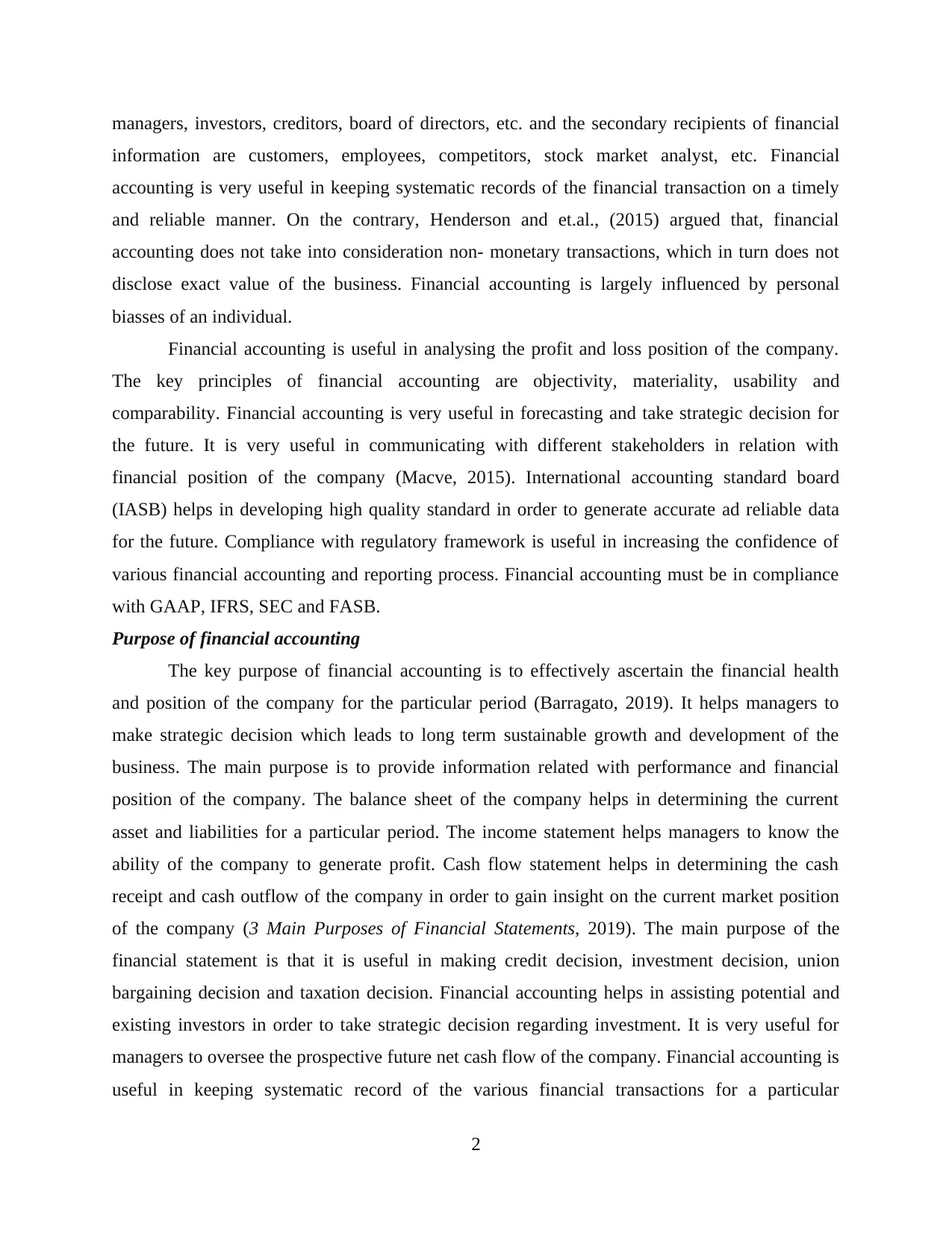
managers, investors, creditors, board of directors, etc. and the secondary recipients of financial
information are customers, employees, competitors, stock market analyst, etc. Financial
accounting is very useful in keeping systematic records of the financial transaction on a timely
and reliable manner. On the contrary, Henderson and et.al., (2015) argued that, financial
accounting does not take into consideration non- monetary transactions, which in turn does not
disclose exact value of the business. Financial accounting is largely influenced by personal
biasses of an individual.
Financial accounting is useful in analysing the profit and loss position of the company.
The key principles of financial accounting are objectivity, materiality, usability and
comparability. Financial accounting is very useful in forecasting and take strategic decision for
the future. It is very useful in communicating with different stakeholders in relation with
financial position of the company (Macve, 2015). International accounting standard board
(IASB) helps in developing high quality standard in order to generate accurate ad reliable data
for the future. Compliance with regulatory framework is useful in increasing the confidence of
various financial accounting and reporting process. Financial accounting must be in compliance
with GAAP, IFRS, SEC and FASB.
Purpose of financial accounting
The key purpose of financial accounting is to effectively ascertain the financial health
and position of the company for the particular period (Barragato, 2019). It helps managers to
make strategic decision which leads to long term sustainable growth and development of the
business. The main purpose is to provide information related with performance and financial
position of the company. The balance sheet of the company helps in determining the current
asset and liabilities for a particular period. The income statement helps managers to know the
ability of the company to generate profit. Cash flow statement helps in determining the cash
receipt and cash outflow of the company in order to gain insight on the current market position
of the company (3 Main Purposes of Financial Statements, 2019). The main purpose of the
financial statement is that it is useful in making credit decision, investment decision, union
bargaining decision and taxation decision. Financial accounting helps in assisting potential and
existing investors in order to take strategic decision regarding investment. It is very useful for
managers to oversee the prospective future net cash flow of the company. Financial accounting is
useful in keeping systematic record of the various financial transactions for a particular
2
information are customers, employees, competitors, stock market analyst, etc. Financial
accounting is very useful in keeping systematic records of the financial transaction on a timely
and reliable manner. On the contrary, Henderson and et.al., (2015) argued that, financial
accounting does not take into consideration non- monetary transactions, which in turn does not
disclose exact value of the business. Financial accounting is largely influenced by personal
biasses of an individual.
Financial accounting is useful in analysing the profit and loss position of the company.
The key principles of financial accounting are objectivity, materiality, usability and
comparability. Financial accounting is very useful in forecasting and take strategic decision for
the future. It is very useful in communicating with different stakeholders in relation with
financial position of the company (Macve, 2015). International accounting standard board
(IASB) helps in developing high quality standard in order to generate accurate ad reliable data
for the future. Compliance with regulatory framework is useful in increasing the confidence of
various financial accounting and reporting process. Financial accounting must be in compliance
with GAAP, IFRS, SEC and FASB.
Purpose of financial accounting
The key purpose of financial accounting is to effectively ascertain the financial health
and position of the company for the particular period (Barragato, 2019). It helps managers to
make strategic decision which leads to long term sustainable growth and development of the
business. The main purpose is to provide information related with performance and financial
position of the company. The balance sheet of the company helps in determining the current
asset and liabilities for a particular period. The income statement helps managers to know the
ability of the company to generate profit. Cash flow statement helps in determining the cash
receipt and cash outflow of the company in order to gain insight on the current market position
of the company (3 Main Purposes of Financial Statements, 2019). The main purpose of the
financial statement is that it is useful in making credit decision, investment decision, union
bargaining decision and taxation decision. Financial accounting helps in assisting potential and
existing investors in order to take strategic decision regarding investment. It is very useful for
managers to oversee the prospective future net cash flow of the company. Financial accounting is
useful in keeping systematic record of the various financial transactions for a particular
2
Secure Best Marks with AI Grader
Need help grading? Try our AI Grader for instant feedback on your assignments.
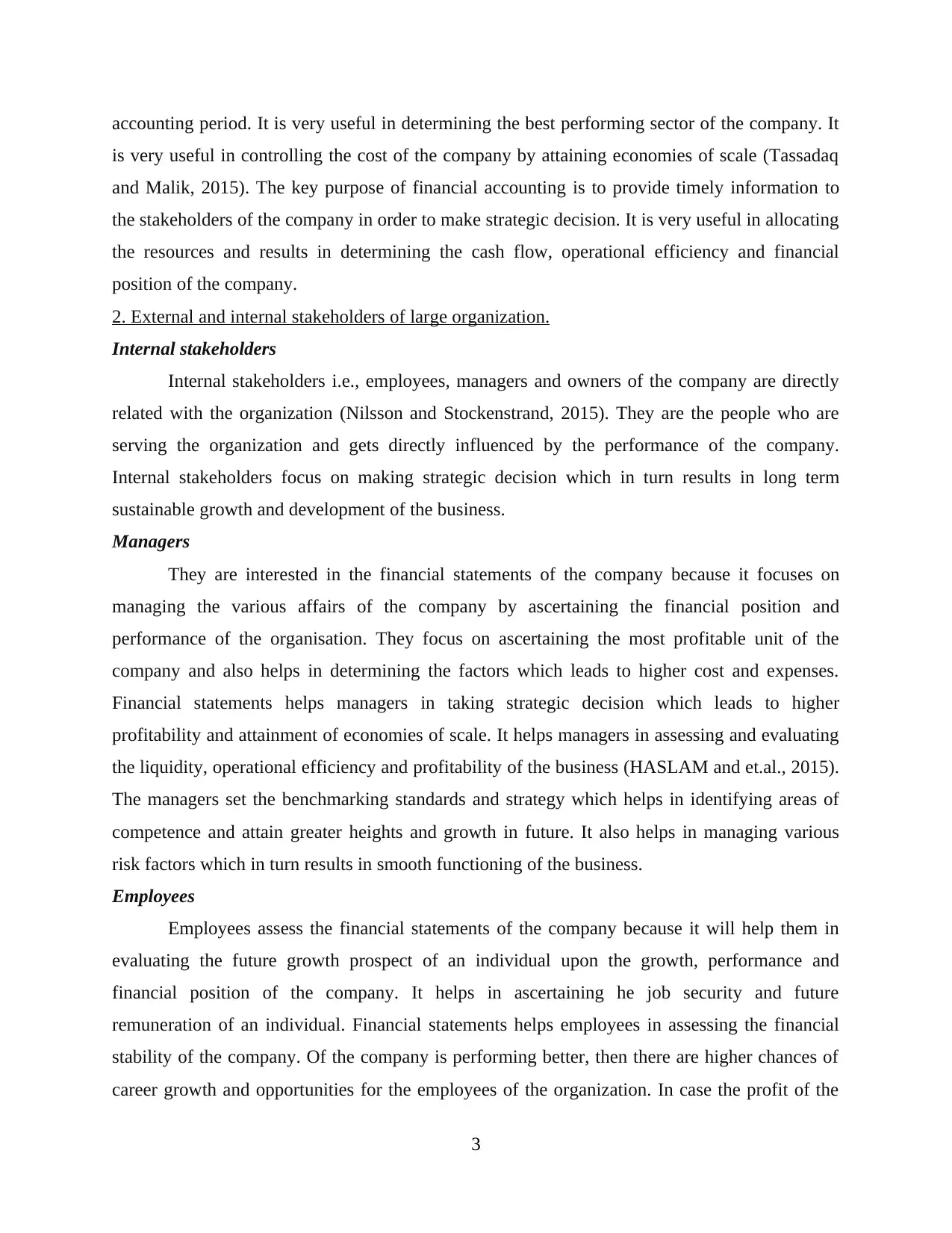
accounting period. It is very useful in determining the best performing sector of the company. It
is very useful in controlling the cost of the company by attaining economies of scale (Tassadaq
and Malik, 2015). The key purpose of financial accounting is to provide timely information to
the stakeholders of the company in order to make strategic decision. It is very useful in allocating
the resources and results in determining the cash flow, operational efficiency and financial
position of the company.
2. External and internal stakeholders of large organization.
Internal stakeholders
Internal stakeholders i.e., employees, managers and owners of the company are directly
related with the organization (Nilsson and Stockenstrand, 2015). They are the people who are
serving the organization and gets directly influenced by the performance of the company.
Internal stakeholders focus on making strategic decision which in turn results in long term
sustainable growth and development of the business.
Managers
They are interested in the financial statements of the company because it focuses on
managing the various affairs of the company by ascertaining the financial position and
performance of the organisation. They focus on ascertaining the most profitable unit of the
company and also helps in determining the factors which leads to higher cost and expenses.
Financial statements helps managers in taking strategic decision which leads to higher
profitability and attainment of economies of scale. It helps managers in assessing and evaluating
the liquidity, operational efficiency and profitability of the business (HASLAM and et.al., 2015).
The managers set the benchmarking standards and strategy which helps in identifying areas of
competence and attain greater heights and growth in future. It also helps in managing various
risk factors which in turn results in smooth functioning of the business.
Employees
Employees assess the financial statements of the company because it will help them in
evaluating the future growth prospect of an individual upon the growth, performance and
financial position of the company. It helps in ascertaining he job security and future
remuneration of an individual. Financial statements helps employees in assessing the financial
stability of the company. Of the company is performing better, then there are higher chances of
career growth and opportunities for the employees of the organization. In case the profit of the
3
is very useful in controlling the cost of the company by attaining economies of scale (Tassadaq
and Malik, 2015). The key purpose of financial accounting is to provide timely information to
the stakeholders of the company in order to make strategic decision. It is very useful in allocating
the resources and results in determining the cash flow, operational efficiency and financial
position of the company.
2. External and internal stakeholders of large organization.
Internal stakeholders
Internal stakeholders i.e., employees, managers and owners of the company are directly
related with the organization (Nilsson and Stockenstrand, 2015). They are the people who are
serving the organization and gets directly influenced by the performance of the company.
Internal stakeholders focus on making strategic decision which in turn results in long term
sustainable growth and development of the business.
Managers
They are interested in the financial statements of the company because it focuses on
managing the various affairs of the company by ascertaining the financial position and
performance of the organisation. They focus on ascertaining the most profitable unit of the
company and also helps in determining the factors which leads to higher cost and expenses.
Financial statements helps managers in taking strategic decision which leads to higher
profitability and attainment of economies of scale. It helps managers in assessing and evaluating
the liquidity, operational efficiency and profitability of the business (HASLAM and et.al., 2015).
The managers set the benchmarking standards and strategy which helps in identifying areas of
competence and attain greater heights and growth in future. It also helps in managing various
risk factors which in turn results in smooth functioning of the business.
Employees
Employees assess the financial statements of the company because it will help them in
evaluating the future growth prospect of an individual upon the growth, performance and
financial position of the company. It helps in ascertaining he job security and future
remuneration of an individual. Financial statements helps employees in assessing the financial
stability of the company. Of the company is performing better, then there are higher chances of
career growth and opportunities for the employees of the organization. In case the profit of the
3
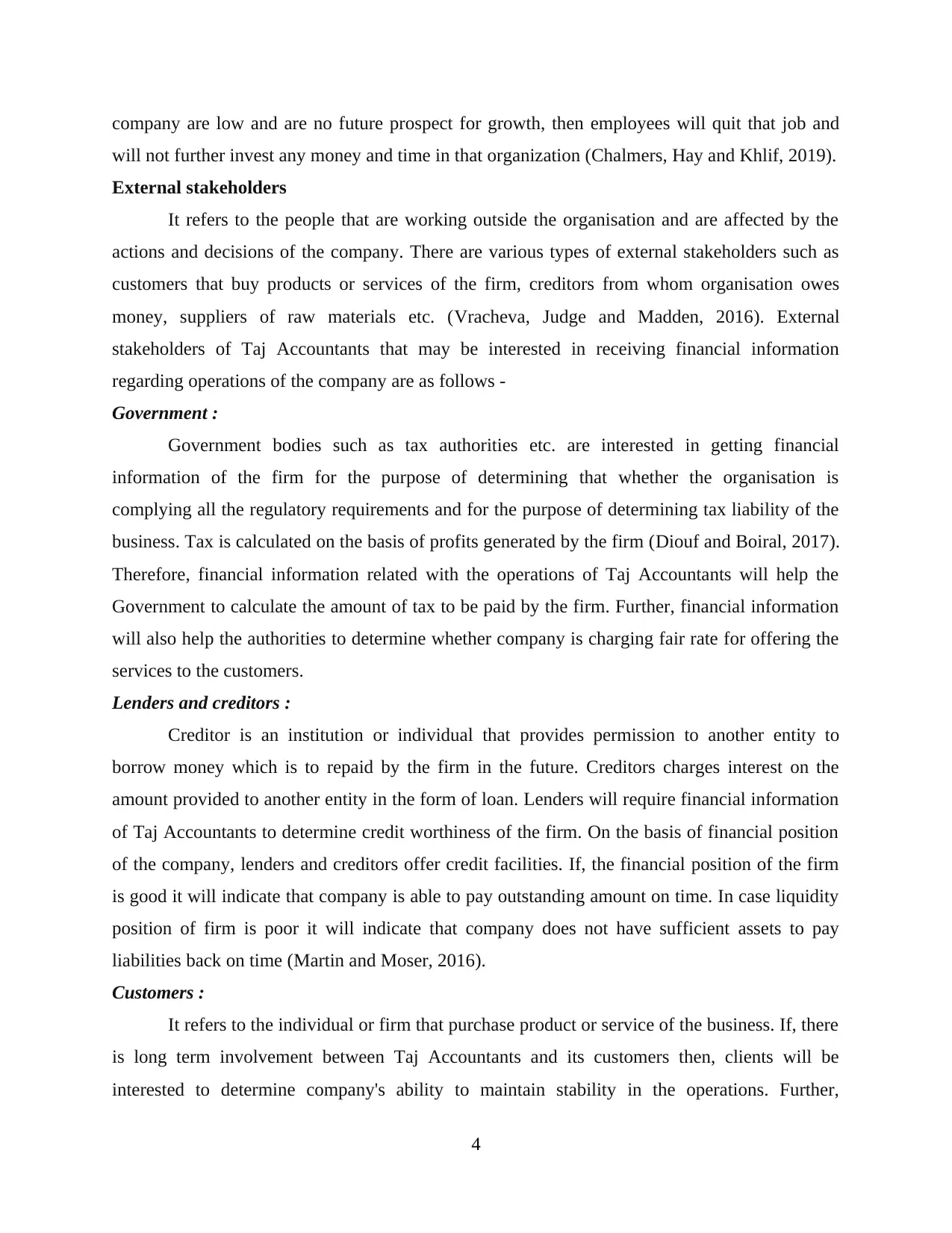
company are low and are no future prospect for growth, then employees will quit that job and
will not further invest any money and time in that organization (Chalmers, Hay and Khlif, 2019).
External stakeholders
It refers to the people that are working outside the organisation and are affected by the
actions and decisions of the company. There are various types of external stakeholders such as
customers that buy products or services of the firm, creditors from whom organisation owes
money, suppliers of raw materials etc. (Vracheva, Judge and Madden, 2016). External
stakeholders of Taj Accountants that may be interested in receiving financial information
regarding operations of the company are as follows -
Government :
Government bodies such as tax authorities etc. are interested in getting financial
information of the firm for the purpose of determining that whether the organisation is
complying all the regulatory requirements and for the purpose of determining tax liability of the
business. Tax is calculated on the basis of profits generated by the firm (Diouf and Boiral, 2017).
Therefore, financial information related with the operations of Taj Accountants will help the
Government to calculate the amount of tax to be paid by the firm. Further, financial information
will also help the authorities to determine whether company is charging fair rate for offering the
services to the customers.
Lenders and creditors :
Creditor is an institution or individual that provides permission to another entity to
borrow money which is to repaid by the firm in the future. Creditors charges interest on the
amount provided to another entity in the form of loan. Lenders will require financial information
of Taj Accountants to determine credit worthiness of the firm. On the basis of financial position
of the company, lenders and creditors offer credit facilities. If, the financial position of the firm
is good it will indicate that company is able to pay outstanding amount on time. In case liquidity
position of firm is poor it will indicate that company does not have sufficient assets to pay
liabilities back on time (Martin and Moser, 2016).
Customers :
It refers to the individual or firm that purchase product or service of the business. If, there
is long term involvement between Taj Accountants and its customers then, clients will be
interested to determine company's ability to maintain stability in the operations. Further,
4
will not further invest any money and time in that organization (Chalmers, Hay and Khlif, 2019).
External stakeholders
It refers to the people that are working outside the organisation and are affected by the
actions and decisions of the company. There are various types of external stakeholders such as
customers that buy products or services of the firm, creditors from whom organisation owes
money, suppliers of raw materials etc. (Vracheva, Judge and Madden, 2016). External
stakeholders of Taj Accountants that may be interested in receiving financial information
regarding operations of the company are as follows -
Government :
Government bodies such as tax authorities etc. are interested in getting financial
information of the firm for the purpose of determining that whether the organisation is
complying all the regulatory requirements and for the purpose of determining tax liability of the
business. Tax is calculated on the basis of profits generated by the firm (Diouf and Boiral, 2017).
Therefore, financial information related with the operations of Taj Accountants will help the
Government to calculate the amount of tax to be paid by the firm. Further, financial information
will also help the authorities to determine whether company is charging fair rate for offering the
services to the customers.
Lenders and creditors :
Creditor is an institution or individual that provides permission to another entity to
borrow money which is to repaid by the firm in the future. Creditors charges interest on the
amount provided to another entity in the form of loan. Lenders will require financial information
of Taj Accountants to determine credit worthiness of the firm. On the basis of financial position
of the company, lenders and creditors offer credit facilities. If, the financial position of the firm
is good it will indicate that company is able to pay outstanding amount on time. In case liquidity
position of firm is poor it will indicate that company does not have sufficient assets to pay
liabilities back on time (Martin and Moser, 2016).
Customers :
It refers to the individual or firm that purchase product or service of the business. If, there
is long term involvement between Taj Accountants and its customers then, clients will be
interested to determine company's ability to maintain stability in the operations. Further,
4
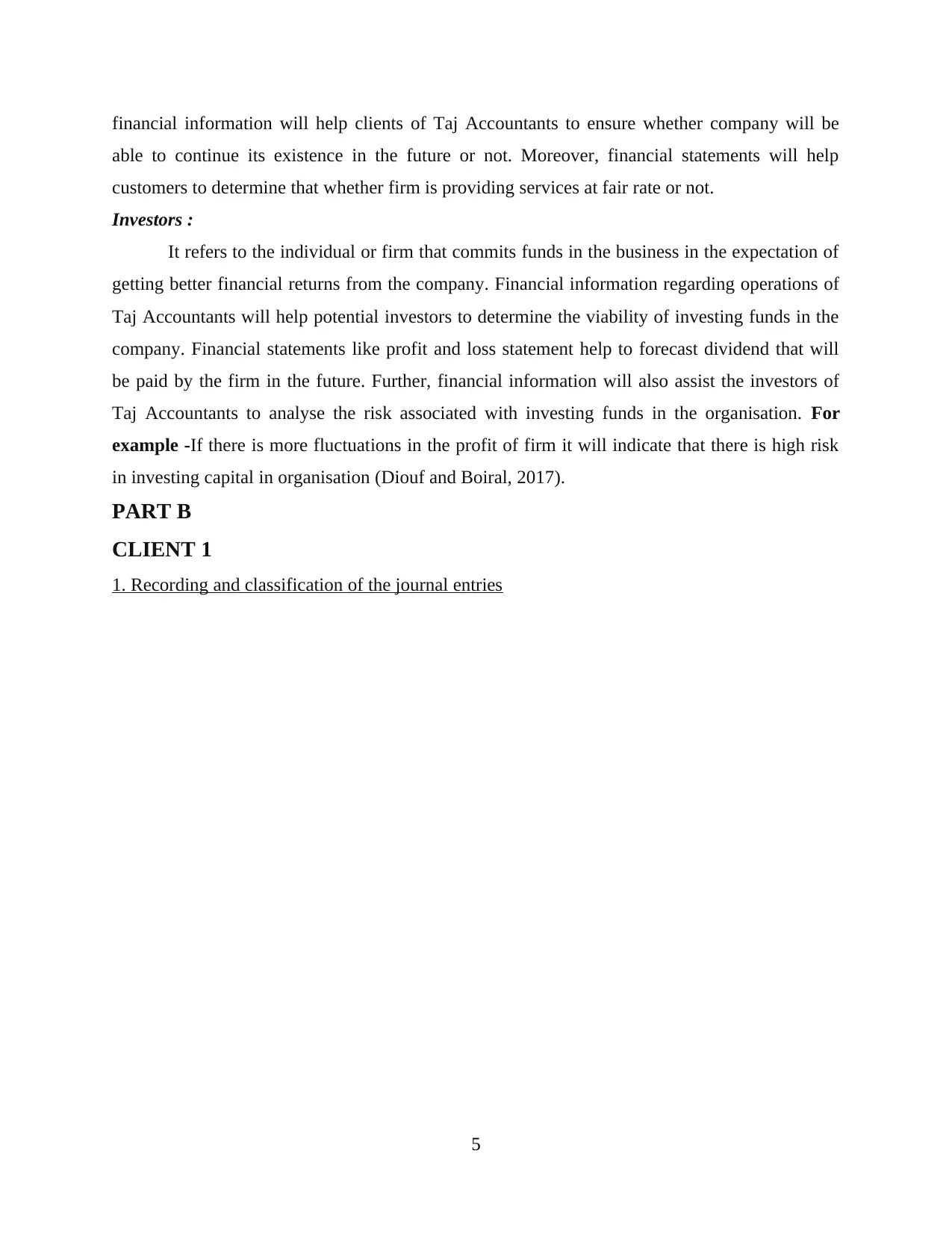
financial information will help clients of Taj Accountants to ensure whether company will be
able to continue its existence in the future or not. Moreover, financial statements will help
customers to determine that whether firm is providing services at fair rate or not.
Investors :
It refers to the individual or firm that commits funds in the business in the expectation of
getting better financial returns from the company. Financial information regarding operations of
Taj Accountants will help potential investors to determine the viability of investing funds in the
company. Financial statements like profit and loss statement help to forecast dividend that will
be paid by the firm in the future. Further, financial information will also assist the investors of
Taj Accountants to analyse the risk associated with investing funds in the organisation. For
example -If there is more fluctuations in the profit of firm it will indicate that there is high risk
in investing capital in organisation (Diouf and Boiral, 2017).
PART B
CLIENT 1
1. Recording and classification of the journal entries
5
able to continue its existence in the future or not. Moreover, financial statements will help
customers to determine that whether firm is providing services at fair rate or not.
Investors :
It refers to the individual or firm that commits funds in the business in the expectation of
getting better financial returns from the company. Financial information regarding operations of
Taj Accountants will help potential investors to determine the viability of investing funds in the
company. Financial statements like profit and loss statement help to forecast dividend that will
be paid by the firm in the future. Further, financial information will also assist the investors of
Taj Accountants to analyse the risk associated with investing funds in the organisation. For
example -If there is more fluctuations in the profit of firm it will indicate that there is high risk
in investing capital in organisation (Diouf and Boiral, 2017).
PART B
CLIENT 1
1. Recording and classification of the journal entries
5
Paraphrase This Document
Need a fresh take? Get an instant paraphrase of this document with our AI Paraphraser
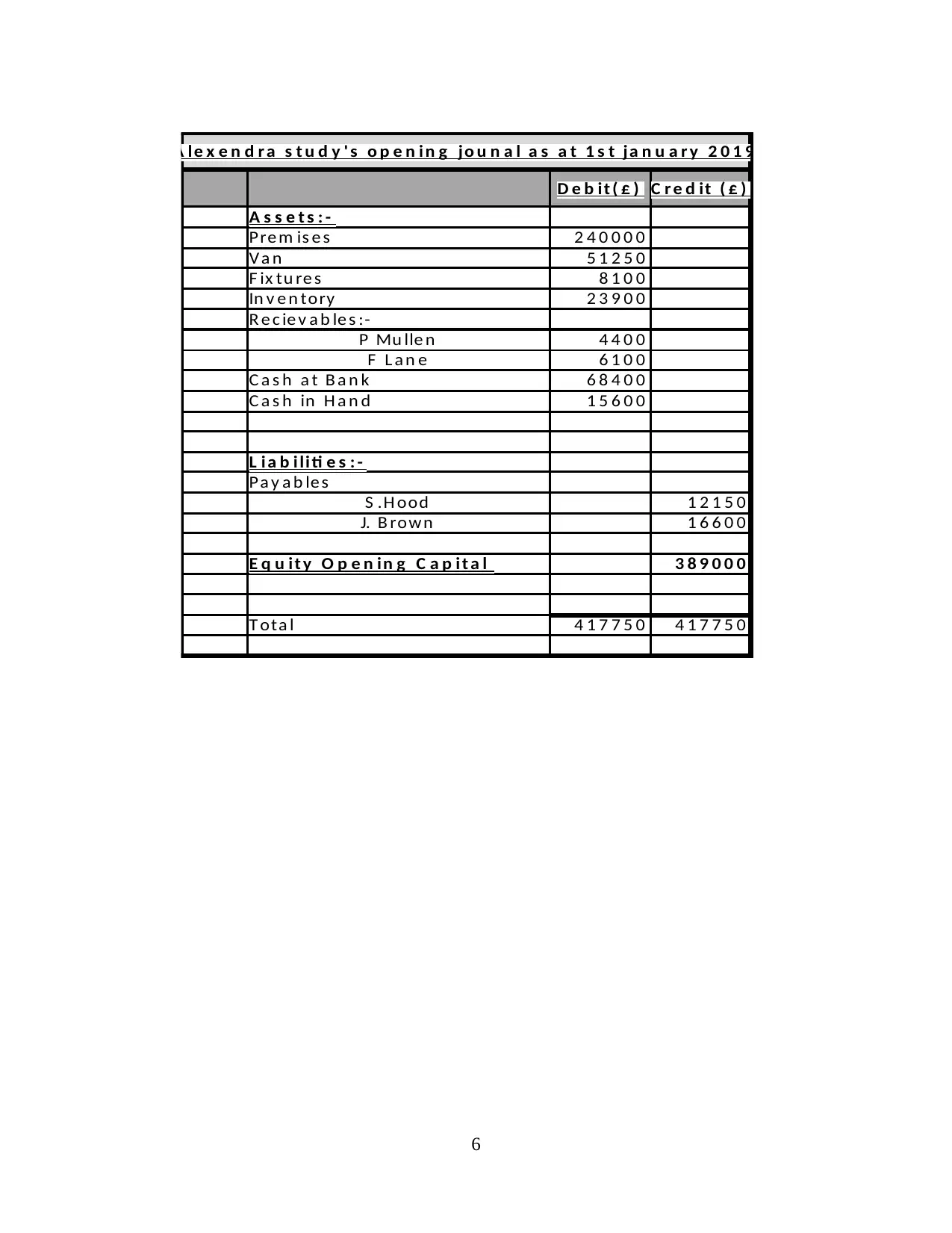
6
A le x e n d r a s t u d y ' s o p e n i n g jo u n a l a s a t 1 s t ja n u a r y 2 0 1 9
D e b i t ( £ ) C r e d it ( £ )
A s s e t s : -
Pre m is e s 2 4 0 0 0 0
V a n 5 1 2 5 0
F ix tu re s 8 1 0 0
In v e n tory 2 3 9 0 0
R e c ie v a b le s :-
P Mu lle n 4 4 0 0
F L a n e 6 1 0 0
C a s h a t B a n k 6 8 4 0 0
C a s h in H a n d 1 5 6 0 0
L i a b i li ti e s : -
Pa y a b le s
S .H ood 1 2 1 5 0
J. B rown 1 6 6 0 0
E q u it y O p e n in g C a p i t a l 3 8 9 0 0 0
T ota l 4 1 7 7 5 0 4 1 7 7 5 0
A le x e n d r a s t u d y ' s o p e n i n g jo u n a l a s a t 1 s t ja n u a r y 2 0 1 9
D e b i t ( £ ) C r e d it ( £ )
A s s e t s : -
Pre m is e s 2 4 0 0 0 0
V a n 5 1 2 5 0
F ix tu re s 8 1 0 0
In v e n tory 2 3 9 0 0
R e c ie v a b le s :-
P Mu lle n 4 4 0 0
F L a n e 6 1 0 0
C a s h a t B a n k 6 8 4 0 0
C a s h in H a n d 1 5 6 0 0
L i a b i li ti e s : -
Pa y a b le s
S .H ood 1 2 1 5 0
J. B rown 1 6 6 0 0
E q u it y O p e n in g C a p i t a l 3 8 9 0 0 0
T ota l 4 1 7 7 5 0 4 1 7 7 5 0

7
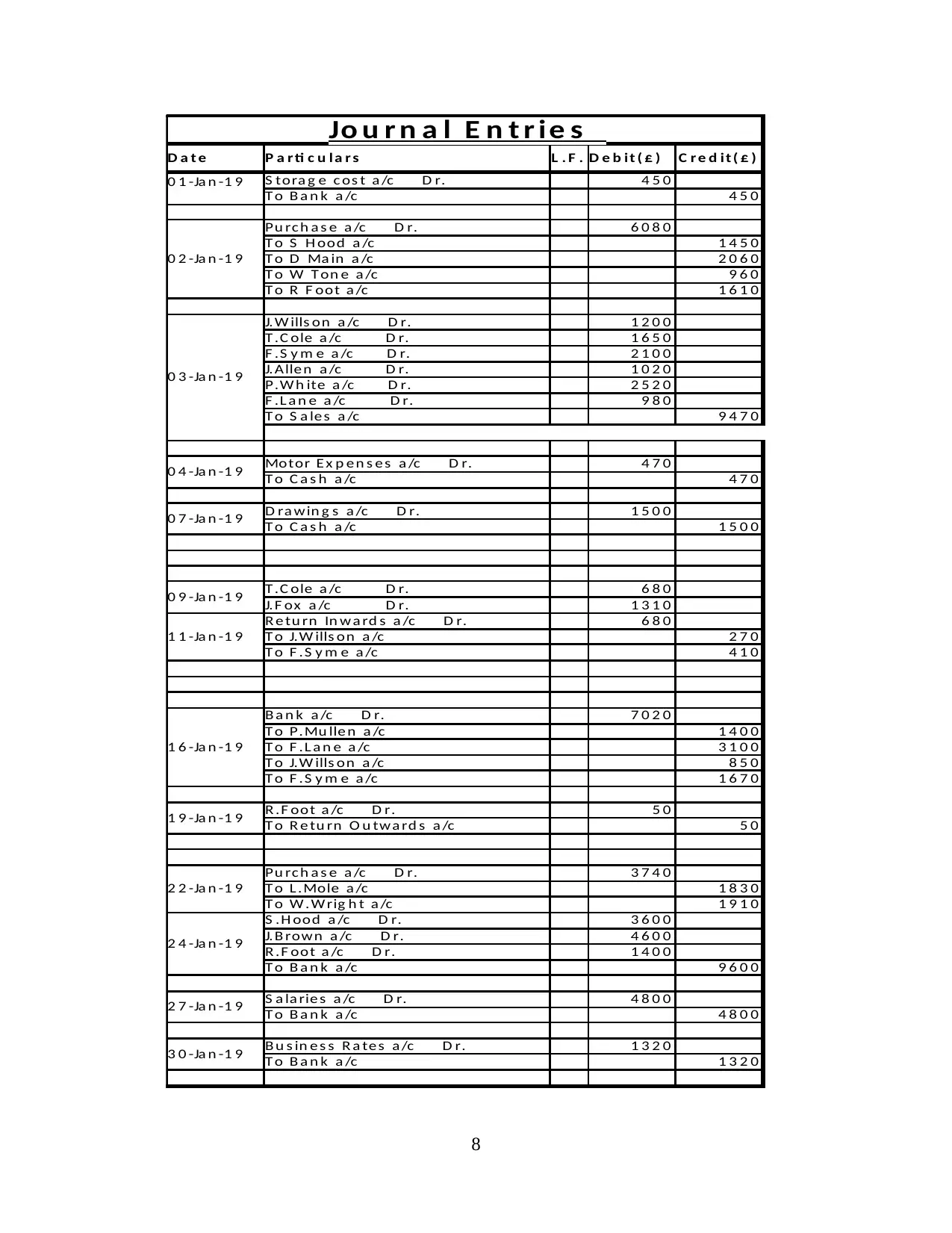
8
Jo u r n a l E n t r ie s
D a t e P a r ti c u la r s L . F . D e b it ( £ ) C r e d it ( £ )
0 1 -Ja n -1 9 S tora g e c os t a /c D r. 4 5 0
T o B a n k a /c 4 5 0
0 2 -Ja n -1 9
Pu rc h a s e a /c D r. 6 0 8 0
T o S H ood a /c 1 4 5 0
T o D Ma in a /c 2 0 6 0
T o W T on e a /c 9 6 0
T o R F oot a /c 1 6 1 0
0 3 -Ja n -1 9
J.W ills on a /c D r. 1 2 0 0
T .C ole a /c D r. 1 6 5 0
F .S y m e a /c D r. 2 1 0 0
J.Alle n a /c D r. 1 0 2 0
P.W h ite a /c D r. 2 5 2 0
F .L a n e a /c D r. 9 8 0
T o S a le s a /c 9 4 7 0
0 4 -Ja n -1 9 Motor E x p e n s e s a /c D r. 4 7 0
T o C a s h a /c 4 7 0
0 7 -Ja n -1 9 D ra w in g s a /c D r. 1 5 0 0
T o C a s h a /c 1 5 0 0
0 9 -Ja n -1 9 T .C ole a /c D r. 6 8 0
J.F ox a /c D r. 1 3 1 0
1 1 -Ja n -1 9
R e tu rn In w a rd s a /c D r. 6 8 0
T o J.W ills on a /c 2 7 0
T o F .S y m e a /c 4 1 0
1 6 -Ja n -1 9
B a n k a /c D r. 7 0 2 0
T o P.Mu lle n a /c 1 4 0 0
T o F .L a n e a /c 3 1 0 0
T o J.W ills on a /c 8 5 0
T o F .S y m e a /c 1 6 7 0
1 9 -Ja n -1 9 R .F oot a /c D r. 5 0
T o R e tu rn O u twa rd s a /c 5 0
2 2 -Ja n -1 9
Pu rc h a s e a /c D r. 3 7 4 0
T o L .Mole a /c 1 8 3 0
T o W .W rig h t a /c 1 9 1 0
2 4 -Ja n -1 9
S .H ood a /c D r. 3 6 0 0
J.B rown a /c D r. 4 6 0 0
R .F oot a /c D r. 1 4 0 0
T o B a n k a /c 9 6 0 0
2 7 -Ja n -1 9 S a la rie s a /c D r. 4 8 0 0
T o B a n k a /c 4 8 0 0
3 0 -Ja n -1 9 B u s in e s s R a te s a /c D r. 1 3 2 0
T o B a n k a /c 1 3 2 0
Jo u r n a l E n t r ie s
D a t e P a r ti c u la r s L . F . D e b it ( £ ) C r e d it ( £ )
0 1 -Ja n -1 9 S tora g e c os t a /c D r. 4 5 0
T o B a n k a /c 4 5 0
0 2 -Ja n -1 9
Pu rc h a s e a /c D r. 6 0 8 0
T o S H ood a /c 1 4 5 0
T o D Ma in a /c 2 0 6 0
T o W T on e a /c 9 6 0
T o R F oot a /c 1 6 1 0
0 3 -Ja n -1 9
J.W ills on a /c D r. 1 2 0 0
T .C ole a /c D r. 1 6 5 0
F .S y m e a /c D r. 2 1 0 0
J.Alle n a /c D r. 1 0 2 0
P.W h ite a /c D r. 2 5 2 0
F .L a n e a /c D r. 9 8 0
T o S a le s a /c 9 4 7 0
0 4 -Ja n -1 9 Motor E x p e n s e s a /c D r. 4 7 0
T o C a s h a /c 4 7 0
0 7 -Ja n -1 9 D ra w in g s a /c D r. 1 5 0 0
T o C a s h a /c 1 5 0 0
0 9 -Ja n -1 9 T .C ole a /c D r. 6 8 0
J.F ox a /c D r. 1 3 1 0
1 1 -Ja n -1 9
R e tu rn In w a rd s a /c D r. 6 8 0
T o J.W ills on a /c 2 7 0
T o F .S y m e a /c 4 1 0
1 6 -Ja n -1 9
B a n k a /c D r. 7 0 2 0
T o P.Mu lle n a /c 1 4 0 0
T o F .L a n e a /c 3 1 0 0
T o J.W ills on a /c 8 5 0
T o F .S y m e a /c 1 6 7 0
1 9 -Ja n -1 9 R .F oot a /c D r. 5 0
T o R e tu rn O u twa rd s a /c 5 0
2 2 -Ja n -1 9
Pu rc h a s e a /c D r. 3 7 4 0
T o L .Mole a /c 1 8 3 0
T o W .W rig h t a /c 1 9 1 0
2 4 -Ja n -1 9
S .H ood a /c D r. 3 6 0 0
J.B rown a /c D r. 4 6 0 0
R .F oot a /c D r. 1 4 0 0
T o B a n k a /c 9 6 0 0
2 7 -Ja n -1 9 S a la rie s a /c D r. 4 8 0 0
T o B a n k a /c 4 8 0 0
3 0 -Ja n -1 9 B u s in e s s R a te s a /c D r. 1 3 2 0
T o B a n k a /c 1 3 2 0
Secure Best Marks with AI Grader
Need help grading? Try our AI Grader for instant feedback on your assignments.
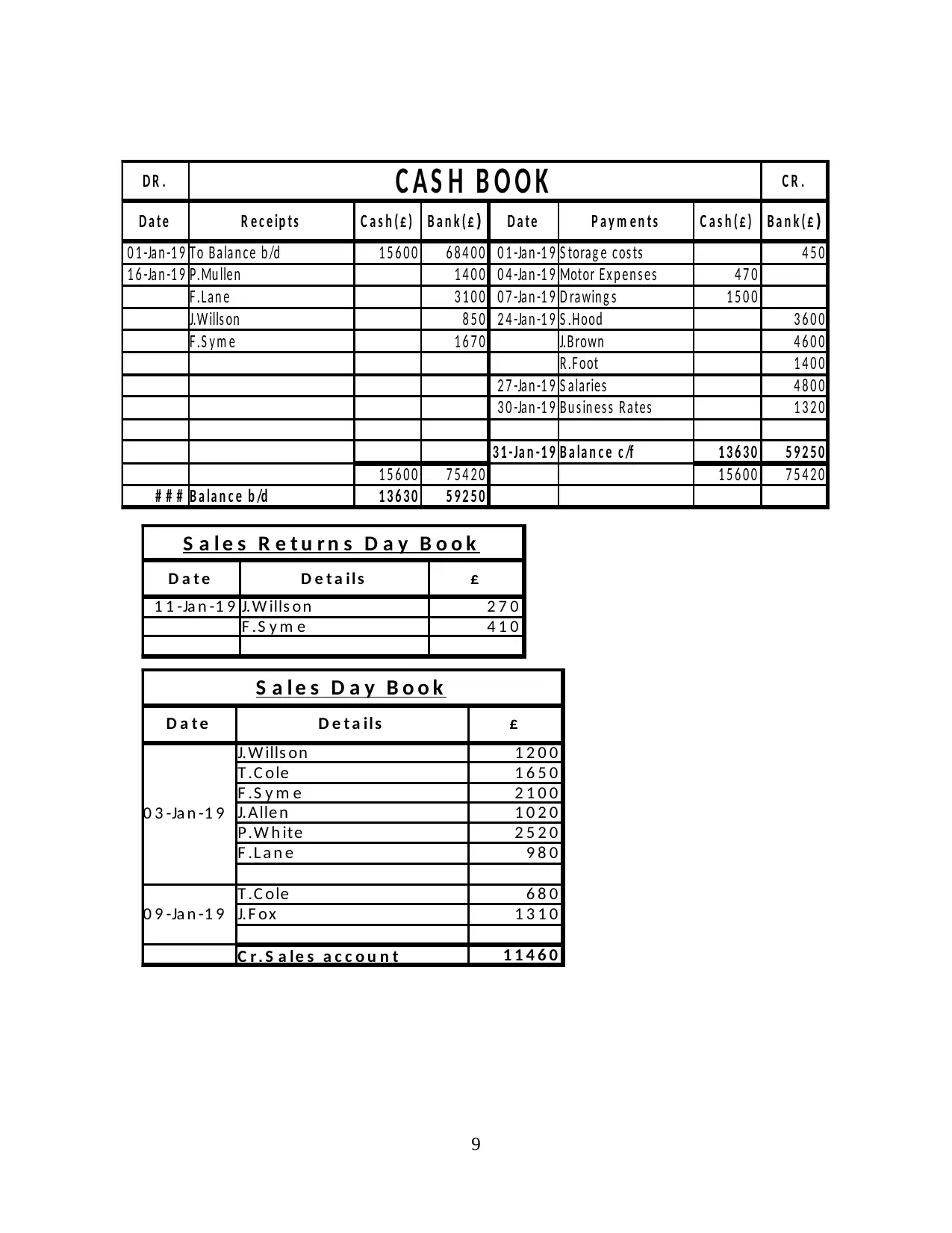
9
D R . C A S H B O O K C R .
D a t e R e c e ip t s C a s h ( £ ) D a t e P a y m e n t s C a s h ( £ )
0 1 -Ja n -1 9 T o B a la n c e b /d 1 5 6 0 0 6 8 4 0 0 0 1 -Ja n -1 9 S tora g e c os ts 4 5 0
1 6 -Ja n -1 9 P.Mu lle n 1 4 0 0 0 4 -Ja n -1 9 Motor E x p e n s e s 4 7 0
F .L a n e 3 1 0 0 0 7 -Ja n -1 9 D ra win g s 1 5 0 0
J.W ills on 8 5 0 2 4 -Ja n -1 9 S .H ood 3 6 0 0
F .S y m e 1 6 7 0 J.B rown 4 6 0 0
R .F oot 1 4 0 0
2 7 -Ja n -1 9 S a la rie s 4 8 0 0
3 0 -Ja n -1 9 B u s in e s s R a te s 1 3 2 0
3 1 -Ja n - 1 9 B a la n c e c /f 1 3 6 3 0 5 9 2 5 0
1 5 6 0 0 7 5 4 2 0 1 5 6 0 0 7 5 4 2 0
# # # B a la n c e b /d 1 3 6 3 0 5 9 2 5 0
B a n k ( £ ) B a n k ( £ )
S a l e s D a y B o o k
D a t e D e t a ils £
0 3 -Ja n -1 9
J.W ills on 1 2 0 0
T .C ole 1 6 5 0
F .S y m e 2 1 0 0
J.Alle n 1 0 2 0
P.W h ite 2 5 2 0
F .L a n e 9 8 0
0 9 -Ja n -1 9
T .C ole 6 8 0
J.F ox 1 3 1 0
C r . S a le s a c c o u n t 1 1 4 6 0
S a l e s R e t u r n s D a y B o o k
D a t e D e t a ils £
1 1 -Ja n -1 9 J.W ills on 2 7 0
F .S y m e 4 1 0
D R . C A S H B O O K C R .
D a t e R e c e ip t s C a s h ( £ ) D a t e P a y m e n t s C a s h ( £ )
0 1 -Ja n -1 9 T o B a la n c e b /d 1 5 6 0 0 6 8 4 0 0 0 1 -Ja n -1 9 S tora g e c os ts 4 5 0
1 6 -Ja n -1 9 P.Mu lle n 1 4 0 0 0 4 -Ja n -1 9 Motor E x p e n s e s 4 7 0
F .L a n e 3 1 0 0 0 7 -Ja n -1 9 D ra win g s 1 5 0 0
J.W ills on 8 5 0 2 4 -Ja n -1 9 S .H ood 3 6 0 0
F .S y m e 1 6 7 0 J.B rown 4 6 0 0
R .F oot 1 4 0 0
2 7 -Ja n -1 9 S a la rie s 4 8 0 0
3 0 -Ja n -1 9 B u s in e s s R a te s 1 3 2 0
3 1 -Ja n - 1 9 B a la n c e c /f 1 3 6 3 0 5 9 2 5 0
1 5 6 0 0 7 5 4 2 0 1 5 6 0 0 7 5 4 2 0
# # # B a la n c e b /d 1 3 6 3 0 5 9 2 5 0
B a n k ( £ ) B a n k ( £ )
S a l e s D a y B o o k
D a t e D e t a ils £
0 3 -Ja n -1 9
J.W ills on 1 2 0 0
T .C ole 1 6 5 0
F .S y m e 2 1 0 0
J.Alle n 1 0 2 0
P.W h ite 2 5 2 0
F .L a n e 9 8 0
0 9 -Ja n -1 9
T .C ole 6 8 0
J.F ox 1 3 1 0
C r . S a le s a c c o u n t 1 1 4 6 0
S a l e s R e t u r n s D a y B o o k
D a t e D e t a ils £
1 1 -Ja n -1 9 J.W ills on 2 7 0
F .S y m e 4 1 0
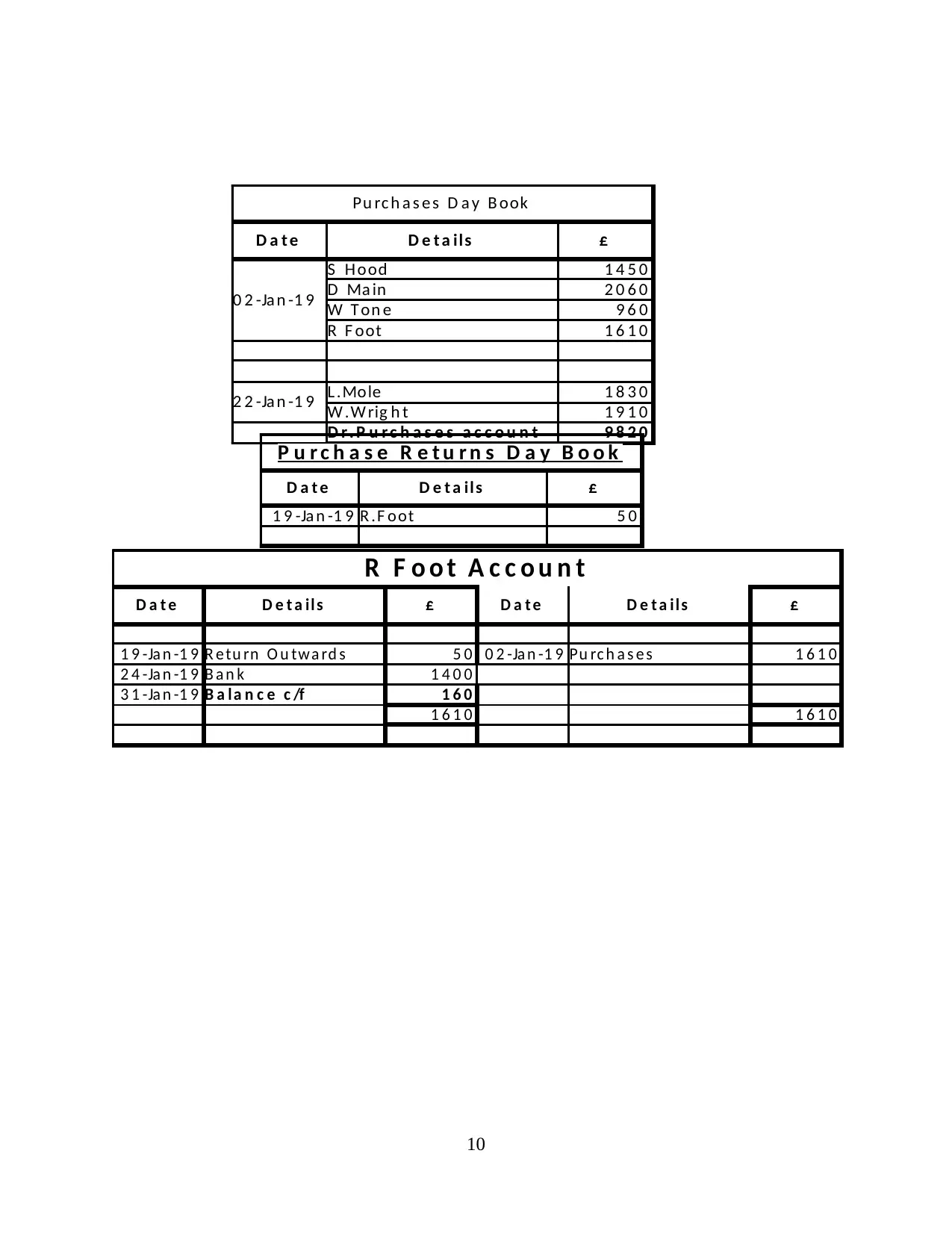
R F o o t A c c o u n t
D a t e D e t a il s £ D a t e D e t a il s £
1 9 -Ja n -1 9 R e tu rn O u tw a rd s 5 0 0 2 -Ja n -1 9 Pu rc h a s e s 1 6 1 0
2 4 -Ja n -1 9 B a n k 1 4 0 0
3 1 -Ja n -1 9 B a l a n c e c /f 1 6 0
1 6 1 0 1 6 1 0
10
Pu rc h a s e s D a y B ook
D a t e D e t a ils £
0 2 -Ja n -1 9
S H ood 1 4 5 0
D Ma in 2 0 6 0
W T on e 9 6 0
R F oot 1 6 1 0
2 2 -Ja n -1 9 L .Mole 1 8 3 0
W .W rig h t 1 9 1 0
D r . P u r c h a s e s a c c o u n t 9 8 2 0
P u r c h a s e R e t u r n s D a y B o o k
D a t e D e t a ils £
1 9 -Ja n -1 9 R .F oot 5 0
D a t e D e t a il s £ D a t e D e t a il s £
1 9 -Ja n -1 9 R e tu rn O u tw a rd s 5 0 0 2 -Ja n -1 9 Pu rc h a s e s 1 6 1 0
2 4 -Ja n -1 9 B a n k 1 4 0 0
3 1 -Ja n -1 9 B a l a n c e c /f 1 6 0
1 6 1 0 1 6 1 0
10
Pu rc h a s e s D a y B ook
D a t e D e t a ils £
0 2 -Ja n -1 9
S H ood 1 4 5 0
D Ma in 2 0 6 0
W T on e 9 6 0
R F oot 1 6 1 0
2 2 -Ja n -1 9 L .Mole 1 8 3 0
W .W rig h t 1 9 1 0
D r . P u r c h a s e s a c c o u n t 9 8 2 0
P u r c h a s e R e t u r n s D a y B o o k
D a t e D e t a ils £
1 9 -Ja n -1 9 R .F oot 5 0
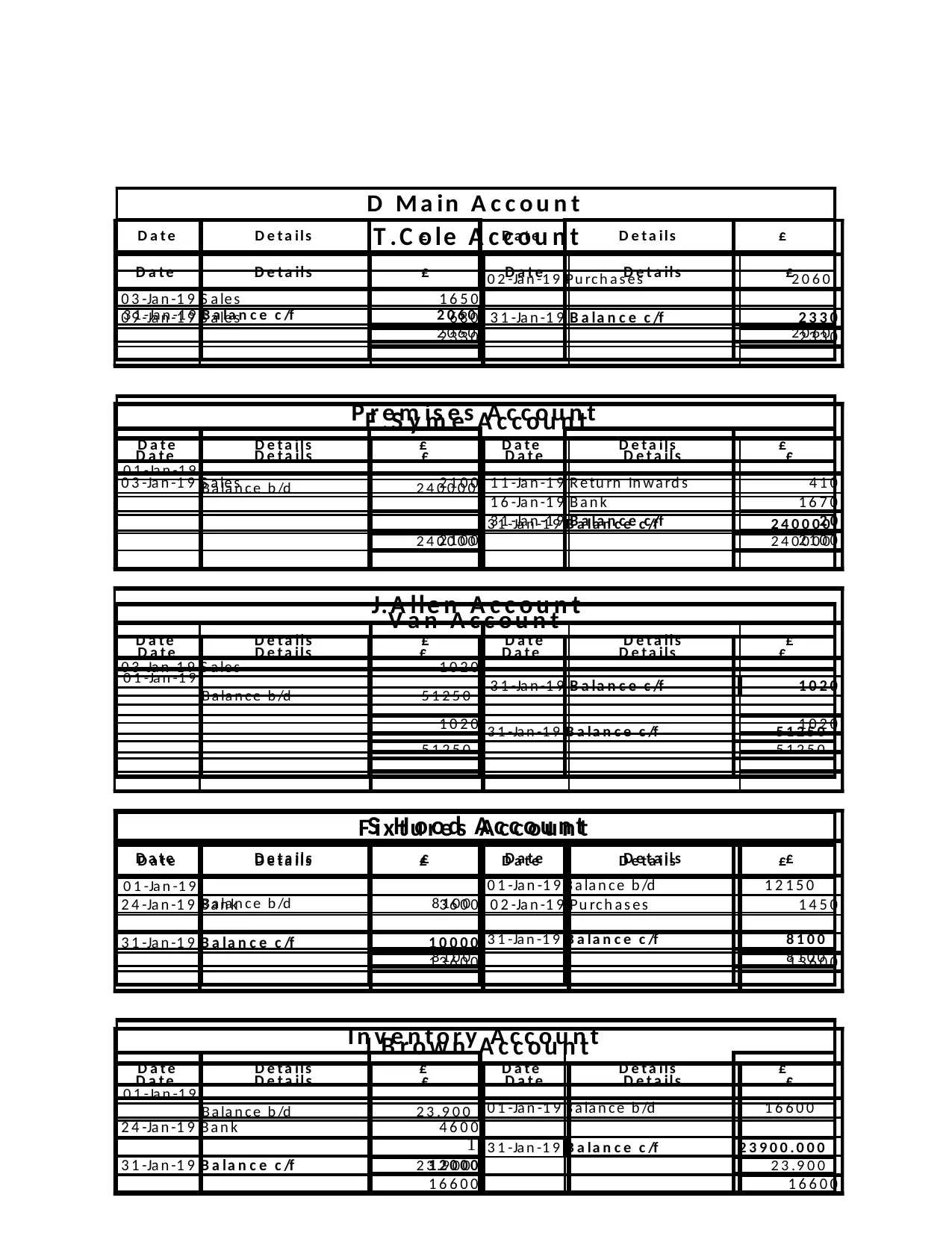
11
T . C o le A c c o u n t
D a t e D e t a ils £ D a t e D e t a il s £
0 3 -Ja n -1 9 S a le s 1 6 5 0
0 9 -Ja n -1 9 S a le s 6 8 0 3 1 -Ja n -1 9 B a la n c e c /f 2 3 3 0
2 3 3 0 2 3 3 0
F . S y m e A c c o u n t
D a t e D e t a ils £ D a t e D e t a il s £
0 3 -Ja n -1 9 S a le s 2 1 0 0 1 1 -Ja n -1 9 R e tu rn In w a rd s 4 1 0
1 6 -Ja n -1 9 B a n k 1 6 7 0
3 1 -Ja n -1 9 B a la n c e c /f 2 0
2 1 0 0 2 1 0 0
J. A lle n A c c o u n t
D a t e D e t a ils £ D a t e D e t a il s £
0 3 -Ja n -1 9 S a le s 1 0 2 0
3 1 -Ja n -1 9 B a la n c e c /f 1 0 2 0
1 0 2 0 1 0 2 0
S H o o d A c c o u n t
D a t e D e t a ils £ D a t e D e t a il s £
0 1 -Ja n -1 9 B a la n c e b /d 1 2 1 5 0
2 4 -Ja n -1 9 B a n k 3 6 0 0 0 2 -Ja n -1 9 Pu rc h a s e s 1 4 5 0
3 1 -Ja n -1 9 B a la n c e c /f 1 0 0 0 0
1 3 6 0 0 1 3 6 0 0
J B r o w n A c c o u n t
D a t e D e t a ils £ D a t e D e t a il s £
0 1 -Ja n -1 9 B a la n c e b /d 1 6 6 0 0
2 4 -Ja n -1 9 B a n k 4 6 0 0
3 1 -Ja n -1 9 B a la n c e c /f 1 2 0 0 0
1 6 6 0 0 1 6 6 0 0
D M a in A c c o u n t
D a t e D e t a ils £ D a t e D e t a ils £
0 2 -Ja n -1 9 Pu rc h a s e s 2 0 6 0
3 1 -Ja n -1 9 B a la n c e c /f 2 0 6 0
2 0 6 0 2 0 6 0
P r e m is e s A c c o u n t
D a t e D e t a ils £ D a t e D e t a ils £
0 1 -Ja n -1 9
B a la n c e b /d 2 4 0 0 0 0
3 1 -Ja n -1 9 B a la n c e c /f 2 4 0 0 0 0
2 4 0 0 0 0 2 4 0 0 0 0
V a n A c c o u n t
D a t e D e t a ils £ D a t e D e t a ils £
0 1 -Ja n -1 9
B a la n c e b /d 5 1 2 5 0
3 1 -Ja n -1 9 B a la n c e c /f 5 1 2 5 0
5 1 2 5 0 5 1 2 5 0
F ix t u r e s A c c o u n t
D a t e D e t a ils £ D a t e D e t a ils £
0 1 -Ja n -1 9
B a la n c e b /d 8 1 0 0
3 1 -Ja n -1 9 B a la n c e c /f 8 1 0 0
8 1 0 0 8 1 0 0
I n v e n t o r y A c c o u n t
D a t e D e t a ils £ D a t e D e t a ils £
0 1 -Ja n -1 9
B a la n c e b /d 2 3 .9 0 0
3 1 -Ja n -1 9 B a la n c e c /f 2 3 9 0 0 . 0 0 0
2 3 .9 0 0 2 3 .9 0 0
T . C o le A c c o u n t
D a t e D e t a ils £ D a t e D e t a il s £
0 3 -Ja n -1 9 S a le s 1 6 5 0
0 9 -Ja n -1 9 S a le s 6 8 0 3 1 -Ja n -1 9 B a la n c e c /f 2 3 3 0
2 3 3 0 2 3 3 0
F . S y m e A c c o u n t
D a t e D e t a ils £ D a t e D e t a il s £
0 3 -Ja n -1 9 S a le s 2 1 0 0 1 1 -Ja n -1 9 R e tu rn In w a rd s 4 1 0
1 6 -Ja n -1 9 B a n k 1 6 7 0
3 1 -Ja n -1 9 B a la n c e c /f 2 0
2 1 0 0 2 1 0 0
J. A lle n A c c o u n t
D a t e D e t a ils £ D a t e D e t a il s £
0 3 -Ja n -1 9 S a le s 1 0 2 0
3 1 -Ja n -1 9 B a la n c e c /f 1 0 2 0
1 0 2 0 1 0 2 0
S H o o d A c c o u n t
D a t e D e t a ils £ D a t e D e t a il s £
0 1 -Ja n -1 9 B a la n c e b /d 1 2 1 5 0
2 4 -Ja n -1 9 B a n k 3 6 0 0 0 2 -Ja n -1 9 Pu rc h a s e s 1 4 5 0
3 1 -Ja n -1 9 B a la n c e c /f 1 0 0 0 0
1 3 6 0 0 1 3 6 0 0
J B r o w n A c c o u n t
D a t e D e t a ils £ D a t e D e t a il s £
0 1 -Ja n -1 9 B a la n c e b /d 1 6 6 0 0
2 4 -Ja n -1 9 B a n k 4 6 0 0
3 1 -Ja n -1 9 B a la n c e c /f 1 2 0 0 0
1 6 6 0 0 1 6 6 0 0
D M a in A c c o u n t
D a t e D e t a ils £ D a t e D e t a ils £
0 2 -Ja n -1 9 Pu rc h a s e s 2 0 6 0
3 1 -Ja n -1 9 B a la n c e c /f 2 0 6 0
2 0 6 0 2 0 6 0
P r e m is e s A c c o u n t
D a t e D e t a ils £ D a t e D e t a ils £
0 1 -Ja n -1 9
B a la n c e b /d 2 4 0 0 0 0
3 1 -Ja n -1 9 B a la n c e c /f 2 4 0 0 0 0
2 4 0 0 0 0 2 4 0 0 0 0
V a n A c c o u n t
D a t e D e t a ils £ D a t e D e t a ils £
0 1 -Ja n -1 9
B a la n c e b /d 5 1 2 5 0
3 1 -Ja n -1 9 B a la n c e c /f 5 1 2 5 0
5 1 2 5 0 5 1 2 5 0
F ix t u r e s A c c o u n t
D a t e D e t a ils £ D a t e D e t a ils £
0 1 -Ja n -1 9
B a la n c e b /d 8 1 0 0
3 1 -Ja n -1 9 B a la n c e c /f 8 1 0 0
8 1 0 0 8 1 0 0
I n v e n t o r y A c c o u n t
D a t e D e t a ils £ D a t e D e t a ils £
0 1 -Ja n -1 9
B a la n c e b /d 2 3 .9 0 0
3 1 -Ja n -1 9 B a la n c e c /f 2 3 9 0 0 . 0 0 0
2 3 .9 0 0 2 3 .9 0 0
Paraphrase This Document
Need a fresh take? Get an instant paraphrase of this document with our AI Paraphraser
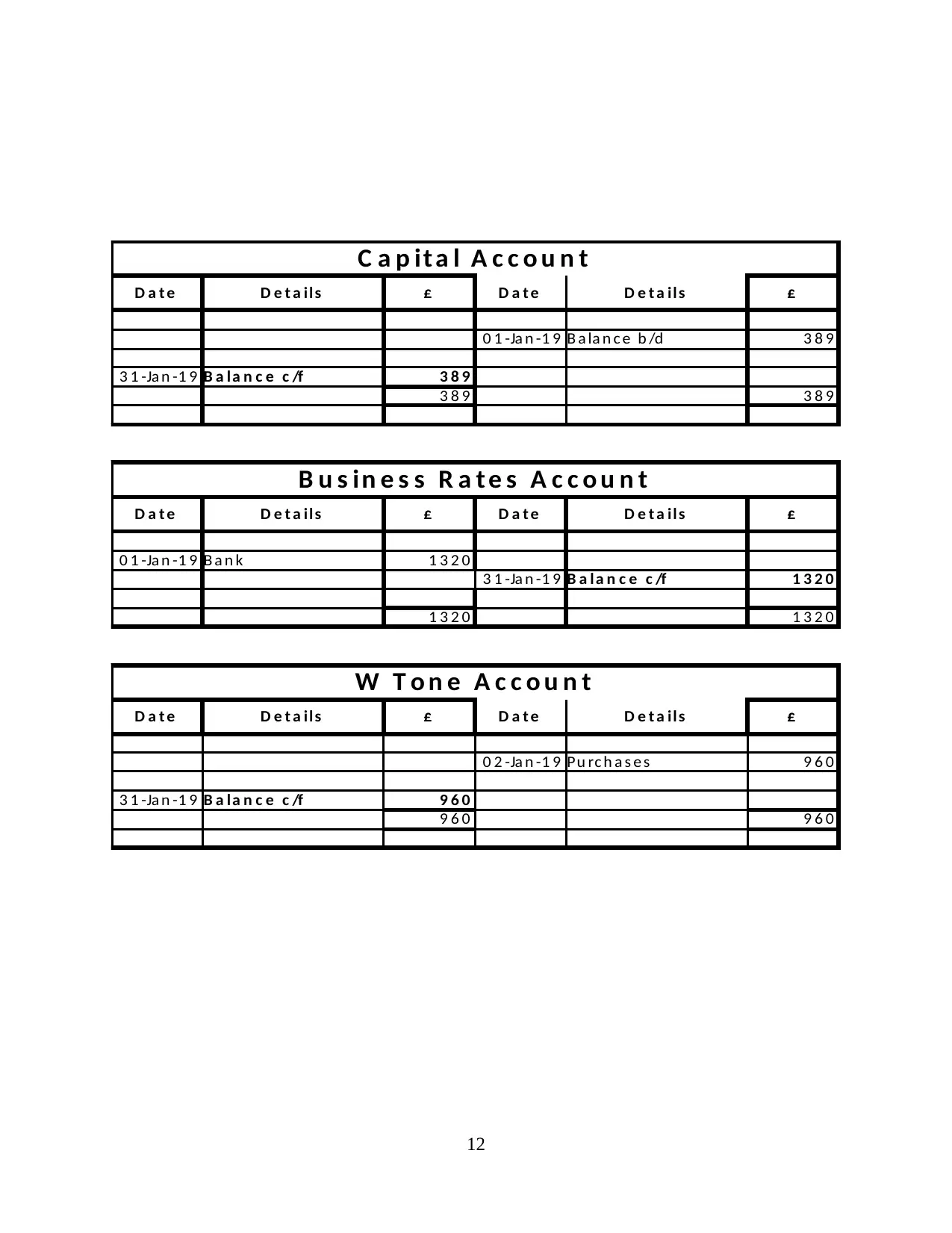
12
C a p it a l A c c o u n t
D a t e D e t a ils £ D a t e D e t a ils £
0 1 -Ja n -1 9 B a la n c e b /d 3 8 9
3 1 -Ja n -1 9 B a la n c e c /f 3 8 9
3 8 9 3 8 9
B u s in e s s R a t e s A c c o u n t
D a t e D e t a ils £ D a t e D e t a ils £
0 1 -Ja n -1 9 B a n k 1 3 2 0
3 1 -Ja n -1 9 B a la n c e c /f 1 3 2 0
1 3 2 0 1 3 2 0
W T o n e A c c o u n t
D a t e D e t a ils £ D a t e D e t a ils £
0 2 -Ja n -1 9 Pu rc h a s e s 9 6 0
3 1 -Ja n -1 9 B a la n c e c /f 9 6 0
9 6 0 9 6 0
C a p it a l A c c o u n t
D a t e D e t a ils £ D a t e D e t a ils £
0 1 -Ja n -1 9 B a la n c e b /d 3 8 9
3 1 -Ja n -1 9 B a la n c e c /f 3 8 9
3 8 9 3 8 9
B u s in e s s R a t e s A c c o u n t
D a t e D e t a ils £ D a t e D e t a ils £
0 1 -Ja n -1 9 B a n k 1 3 2 0
3 1 -Ja n -1 9 B a la n c e c /f 1 3 2 0
1 3 2 0 1 3 2 0
W T o n e A c c o u n t
D a t e D e t a ils £ D a t e D e t a ils £
0 2 -Ja n -1 9 Pu rc h a s e s 9 6 0
3 1 -Ja n -1 9 B a la n c e c /f 9 6 0
9 6 0 9 6 0
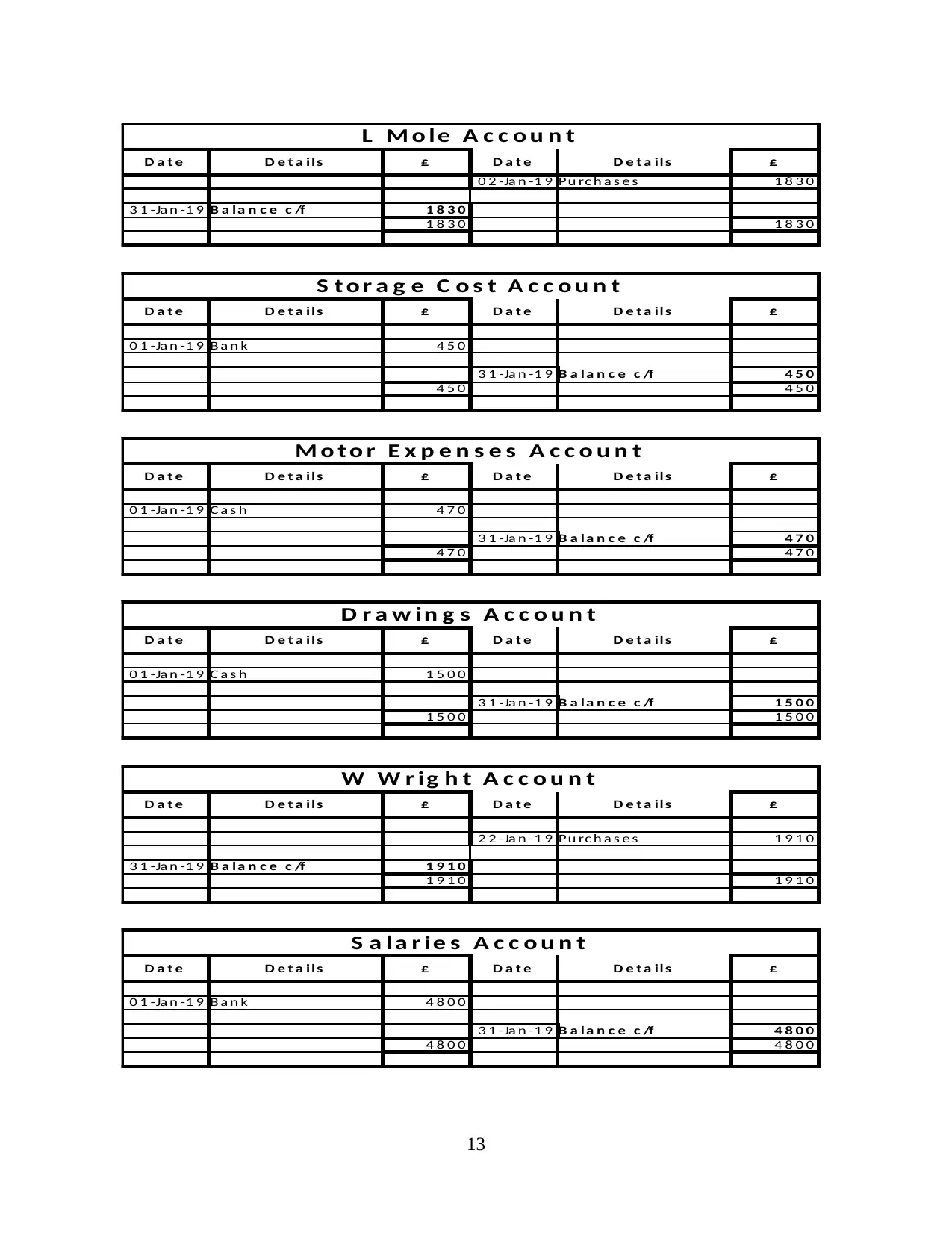
13
L M o le A c c o u n t
D a t e D e t a ils £ D a t e D e t a ils £
0 2 -Ja n -1 9 Pu rc h a s e s 1 8 3 0
3 1 -Ja n -1 9 B a la n c e c /f 1 8 3 0
1 8 3 0 1 8 3 0
S t o r a g e C o s t A c c o u n t
D a t e D e t a ils £ D a t e D e t a ils £
0 1 -Ja n -1 9 B a n k 4 5 0
3 1 -Ja n -1 9 B a la n c e c /f 4 5 0
4 5 0 4 5 0
M o t o r E x p e n s e s A c c o u n t
D a t e D e t a ils £ D a t e D e t a ils £
0 1 -Ja n -1 9 C a s h 4 7 0
3 1 -Ja n -1 9 B a la n c e c /f 4 7 0
4 7 0 4 7 0
D r a w in g s A c c o u n t
D a t e D e t a ils £ D a t e D e t a ils £
0 1 -Ja n -1 9 C a s h 1 5 0 0
3 1 -Ja n -1 9 B a la n c e c /f 1 5 0 0
1 5 0 0 1 5 0 0
W W r ig h t A c c o u n t
D a t e D e t a ils £ D a t e D e t a ils £
2 2 -Ja n -1 9 Pu rc h a s e s 1 9 1 0
3 1 -Ja n -1 9 B a la n c e c /f 1 9 1 0
1 9 1 0 1 9 1 0
S a la r ie s A c c o u n t
D a t e D e t a ils £ D a t e D e t a ils £
0 1 -Ja n -1 9 B a n k 4 8 0 0
3 1 -Ja n -1 9 B a la n c e c /f 4 8 0 0
4 8 0 0 4 8 0 0
L M o le A c c o u n t
D a t e D e t a ils £ D a t e D e t a ils £
0 2 -Ja n -1 9 Pu rc h a s e s 1 8 3 0
3 1 -Ja n -1 9 B a la n c e c /f 1 8 3 0
1 8 3 0 1 8 3 0
S t o r a g e C o s t A c c o u n t
D a t e D e t a ils £ D a t e D e t a ils £
0 1 -Ja n -1 9 B a n k 4 5 0
3 1 -Ja n -1 9 B a la n c e c /f 4 5 0
4 5 0 4 5 0
M o t o r E x p e n s e s A c c o u n t
D a t e D e t a ils £ D a t e D e t a ils £
0 1 -Ja n -1 9 C a s h 4 7 0
3 1 -Ja n -1 9 B a la n c e c /f 4 7 0
4 7 0 4 7 0
D r a w in g s A c c o u n t
D a t e D e t a ils £ D a t e D e t a ils £
0 1 -Ja n -1 9 C a s h 1 5 0 0
3 1 -Ja n -1 9 B a la n c e c /f 1 5 0 0
1 5 0 0 1 5 0 0
W W r ig h t A c c o u n t
D a t e D e t a ils £ D a t e D e t a ils £
2 2 -Ja n -1 9 Pu rc h a s e s 1 9 1 0
3 1 -Ja n -1 9 B a la n c e c /f 1 9 1 0
1 9 1 0 1 9 1 0
S a la r ie s A c c o u n t
D a t e D e t a ils £ D a t e D e t a ils £
0 1 -Ja n -1 9 B a n k 4 8 0 0
3 1 -Ja n -1 9 B a la n c e c /f 4 8 0 0
4 8 0 0 4 8 0 0
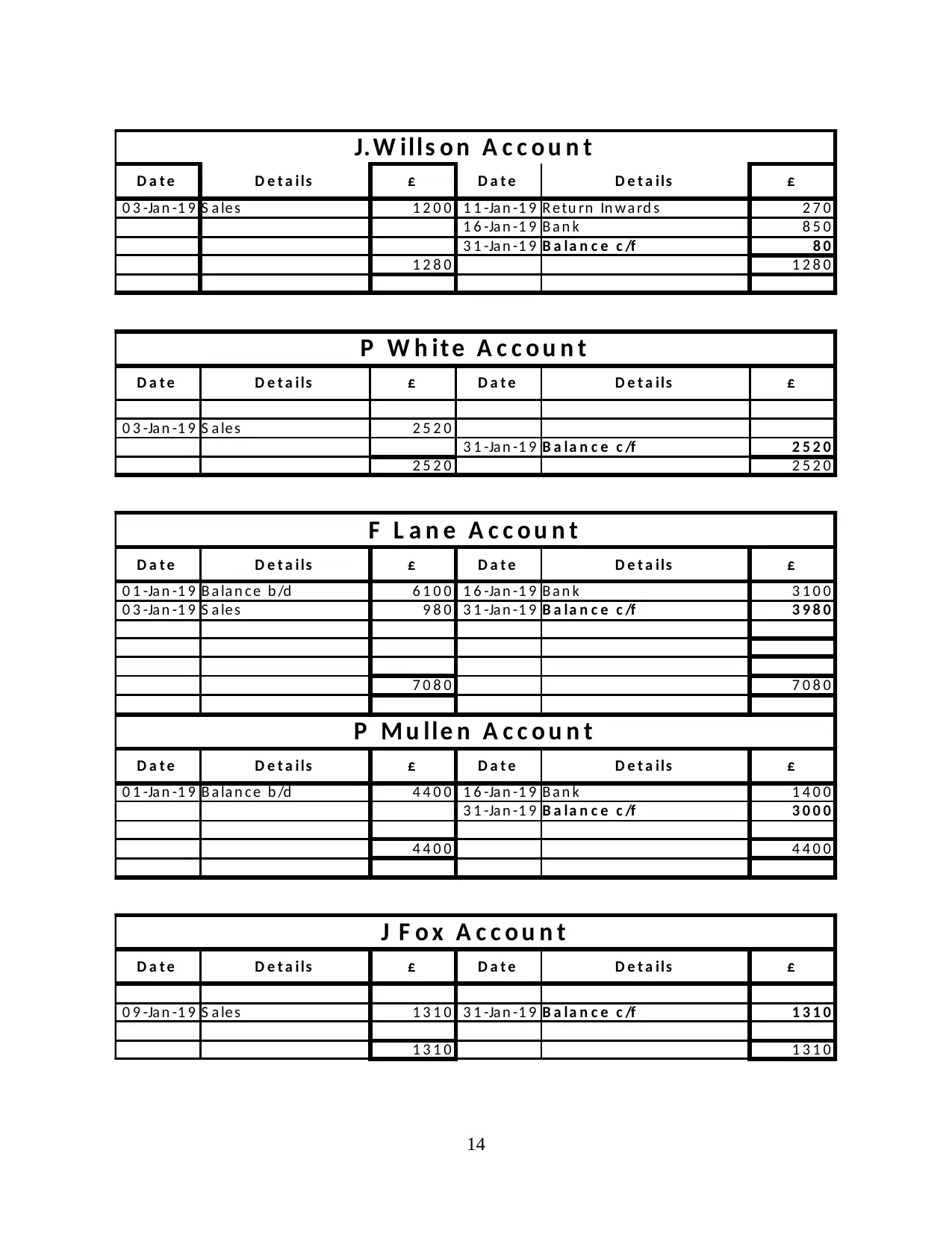
14
J. W ills o n A c c o u n t
D a t e D e t a ils £ D a t e D e t a ils £
0 3 -Ja n -1 9 S a le s 1 2 0 0 1 1 -Ja n -1 9 R e tu rn In w a rd s 2 7 0
1 6 -Ja n -1 9 B a n k 8 5 0
3 1 -Ja n -1 9 B a la n c e c /f 8 0
1 2 8 0 1 2 8 0
P W h it e A c c o u n t
D a t e D e t a ils £ D a t e D e t a ils £
0 3 -Ja n -1 9 S a le s 2 5 2 0
3 1 -Ja n -1 9 B a la n c e c /f 2 5 2 0
2 5 2 0 2 5 2 0
F L a n e A c c o u n t
D a t e D e t a ils £ D a t e D e t a ils £
0 1 -Ja n -1 9 B a la n c e b /d 6 1 0 0 1 6 -Ja n -1 9 B a n k 3 1 0 0
0 3 -Ja n -1 9 S a le s 9 8 0 3 1 -Ja n -1 9 B a la n c e c /f 3 9 8 0
7 0 8 0 7 0 8 0
P M u lle n A c c o u n t
D a t e D e t a ils £ D a t e D e t a ils £
0 1 -Ja n -1 9 B a la n c e b /d 4 4 0 0 1 6 -Ja n -1 9 B a n k 1 4 0 0
3 1 -Ja n -1 9 B a la n c e c /f 3 0 0 0
4 4 0 0 4 4 0 0
J F o x A c c o u n t
D a t e D e t a ils £ D a t e D e t a ils £
0 9 -Ja n -1 9 S a le s 1 3 1 0 3 1 -Ja n -1 9 B a la n c e c /f 1 3 1 0
1 3 1 0 1 3 1 0
J. W ills o n A c c o u n t
D a t e D e t a ils £ D a t e D e t a ils £
0 3 -Ja n -1 9 S a le s 1 2 0 0 1 1 -Ja n -1 9 R e tu rn In w a rd s 2 7 0
1 6 -Ja n -1 9 B a n k 8 5 0
3 1 -Ja n -1 9 B a la n c e c /f 8 0
1 2 8 0 1 2 8 0
P W h it e A c c o u n t
D a t e D e t a ils £ D a t e D e t a ils £
0 3 -Ja n -1 9 S a le s 2 5 2 0
3 1 -Ja n -1 9 B a la n c e c /f 2 5 2 0
2 5 2 0 2 5 2 0
F L a n e A c c o u n t
D a t e D e t a ils £ D a t e D e t a ils £
0 1 -Ja n -1 9 B a la n c e b /d 6 1 0 0 1 6 -Ja n -1 9 B a n k 3 1 0 0
0 3 -Ja n -1 9 S a le s 9 8 0 3 1 -Ja n -1 9 B a la n c e c /f 3 9 8 0
7 0 8 0 7 0 8 0
P M u lle n A c c o u n t
D a t e D e t a ils £ D a t e D e t a ils £
0 1 -Ja n -1 9 B a la n c e b /d 4 4 0 0 1 6 -Ja n -1 9 B a n k 1 4 0 0
3 1 -Ja n -1 9 B a la n c e c /f 3 0 0 0
4 4 0 0 4 4 0 0
J F o x A c c o u n t
D a t e D e t a ils £ D a t e D e t a ils £
0 9 -Ja n -1 9 S a le s 1 3 1 0 3 1 -Ja n -1 9 B a la n c e c /f 1 3 1 0
1 3 1 0 1 3 1 0
Secure Best Marks with AI Grader
Need help grading? Try our AI Grader for instant feedback on your assignments.
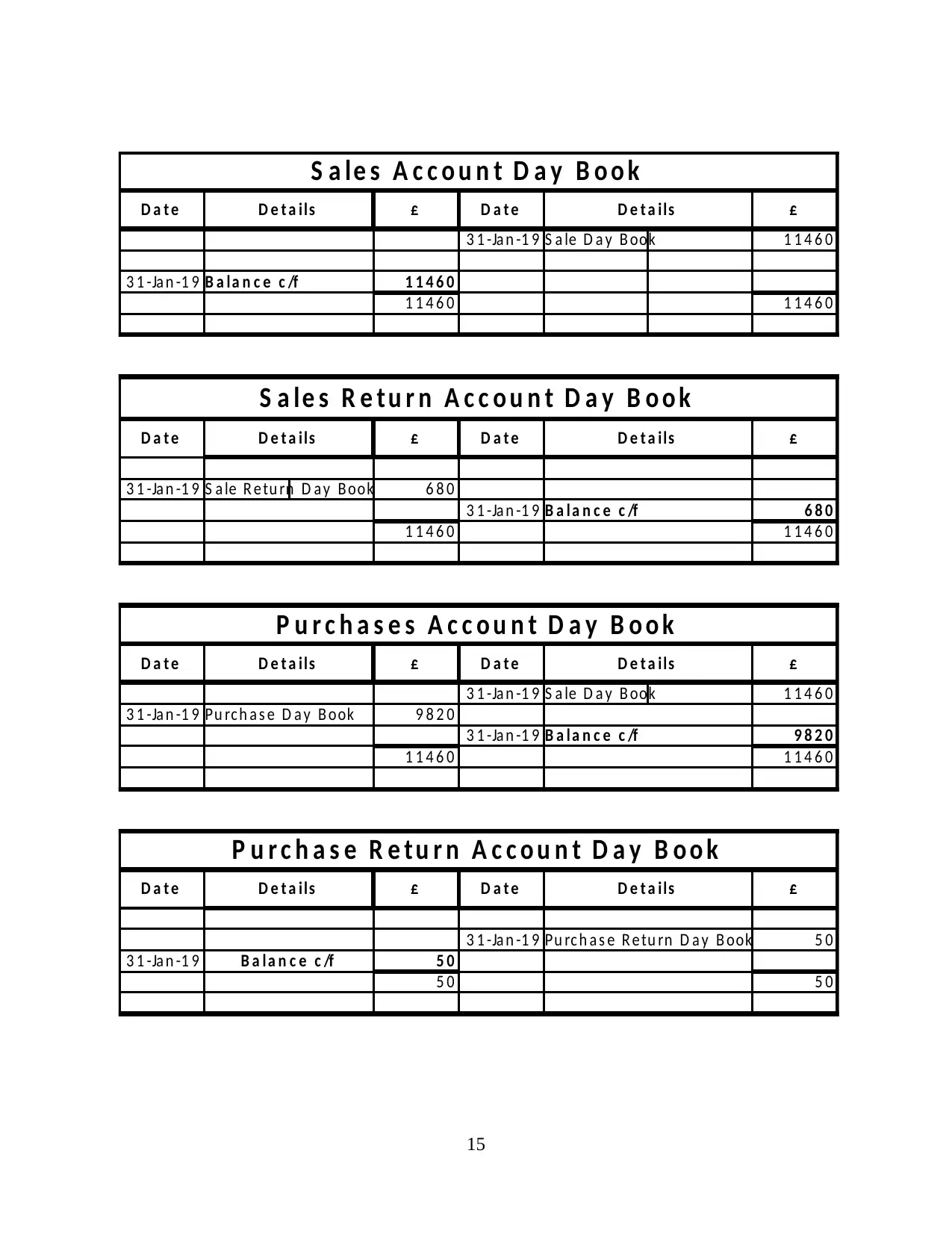
15
S a le s A c c o u n t D a y B o o k
D a t e D e t a i ls £ D a t e D e t a i ls £
3 1 -Ja n -1 9 S a le D a y B ook 1 1 4 6 0
3 1 -Ja n -1 9 B a la n c e c /f 1 1 4 6 0
1 1 4 6 0 1 1 4 6 0
S a le s R e t u r n A c c o u n t D a y B o o k
D a t e D e t a i ls £ D a t e D e t a i ls £
3 1 -Ja n -1 9 S a le R e tu rn D a y B ook 6 8 0
3 1 -Ja n -1 9 B a l a n c e c /f 6 8 0
1 1 4 6 0 1 1 4 6 0
P u r c h a s e s A c c o u n t D a y B o o k
D a t e D e t a i ls £ D a t e D e t a i ls £
3 1 -Ja n -1 9 S a le D a y B ook 1 1 4 6 0
3 1 -Ja n -1 9 Pu rc h a s e D a y B ook 9 8 2 0
3 1 -Ja n -1 9 B a l a n c e c /f 9 8 2 0
1 1 4 6 0 1 1 4 6 0
P u r c h a s e R e t u r n A c c o u n t D a y B o o k
D a t e D e t a i ls £ D a t e D e t a i ls £
3 1 -Ja n -1 9 Pu rc h a s e R e tu rn D a y B ook 5 0
3 1 -Ja n -1 9 B a l a n c e c /f 5 0
5 0 5 0
S a le s A c c o u n t D a y B o o k
D a t e D e t a i ls £ D a t e D e t a i ls £
3 1 -Ja n -1 9 S a le D a y B ook 1 1 4 6 0
3 1 -Ja n -1 9 B a la n c e c /f 1 1 4 6 0
1 1 4 6 0 1 1 4 6 0
S a le s R e t u r n A c c o u n t D a y B o o k
D a t e D e t a i ls £ D a t e D e t a i ls £
3 1 -Ja n -1 9 S a le R e tu rn D a y B ook 6 8 0
3 1 -Ja n -1 9 B a l a n c e c /f 6 8 0
1 1 4 6 0 1 1 4 6 0
P u r c h a s e s A c c o u n t D a y B o o k
D a t e D e t a i ls £ D a t e D e t a i ls £
3 1 -Ja n -1 9 S a le D a y B ook 1 1 4 6 0
3 1 -Ja n -1 9 Pu rc h a s e D a y B ook 9 8 2 0
3 1 -Ja n -1 9 B a l a n c e c /f 9 8 2 0
1 1 4 6 0 1 1 4 6 0
P u r c h a s e R e t u r n A c c o u n t D a y B o o k
D a t e D e t a i ls £ D a t e D e t a i ls £
3 1 -Ja n -1 9 Pu rc h a s e R e tu rn D a y B ook 5 0
3 1 -Ja n -1 9 B a l a n c e c /f 5 0
5 0 5 0
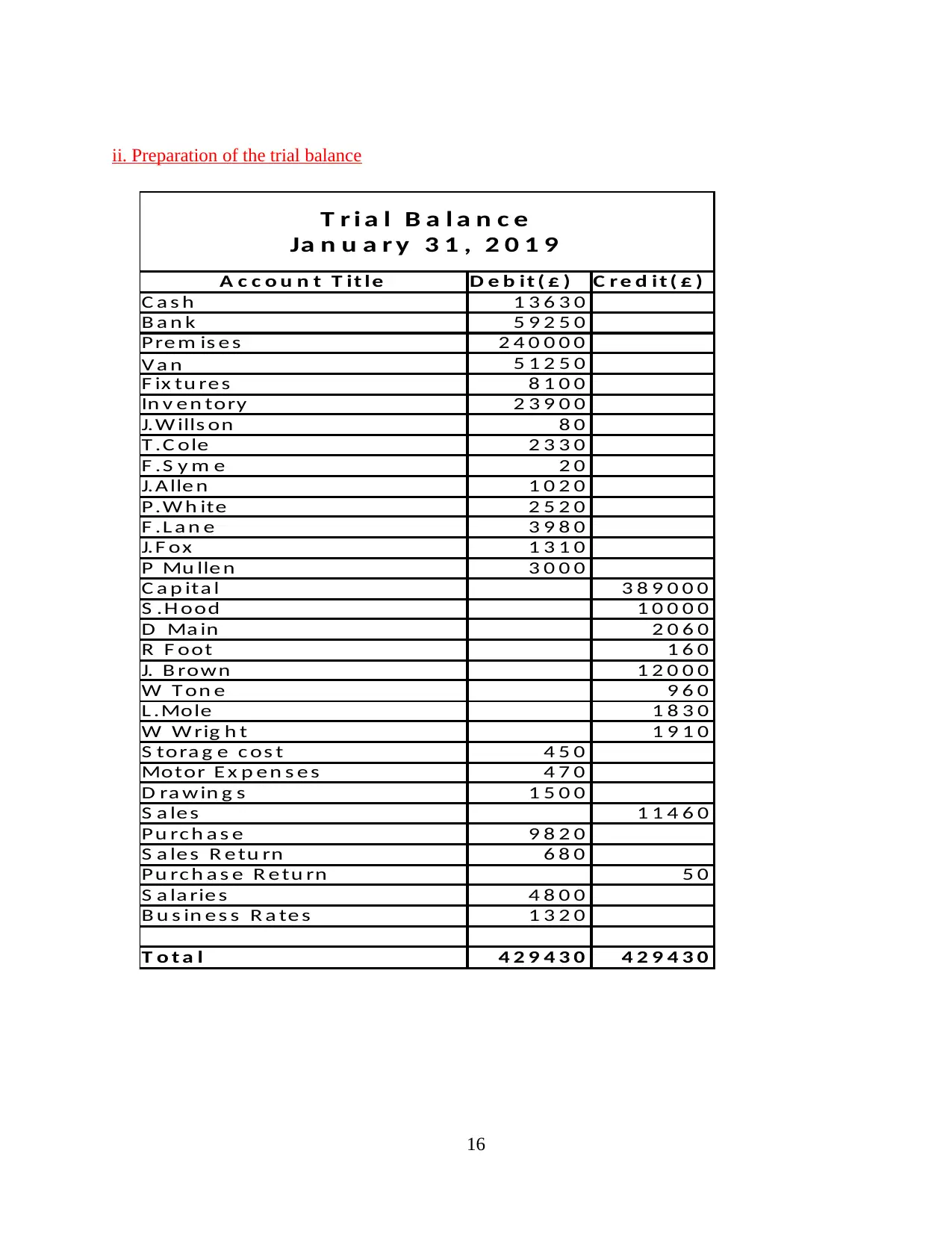
ii. Preparation of the trial balance
16
A c c o u n t T it le D e b it ( £ ) C r e d it ( £ )
C a s h 1 3 6 3 0
B a n k 5 9 2 5 0
Pre m is e s 2 4 0 0 0 0
V a n 5 1 2 5 0
F ix tu re s 8 1 0 0
In v e n tory 2 3 9 0 0
J.W ills on 8 0
T .C ole 2 3 3 0
F .S y m e 2 0
J.A lle n 1 0 2 0
P.W h ite 2 5 2 0
F .L a n e 3 9 8 0
J.F ox 1 3 1 0
P Mu lle n 3 0 0 0
C a p ita l 3 8 9 0 0 0
S .H ood 1 0 0 0 0
D Ma in 2 0 6 0
R F oot 1 6 0
J. B rown 1 2 0 0 0
W T on e 9 6 0
L .Mole 1 8 3 0
W W rig h t 1 9 1 0
S tora g e c os t 4 5 0
Motor E x p e n s e s 4 7 0
D ra w in g s 1 5 0 0
S a le s 1 1 4 6 0
Pu rc h a s e 9 8 2 0
S a le s R e tu rn 6 8 0
Pu rc h a s e R e tu rn 5 0
S a la rie s 4 8 0 0
B u s in e s s R a te s 1 3 2 0
T o t a l 4 2 9 4 3 0 4 2 9 4 3 0
T r i a l B a l a n c e
Ja n u a r y 3 1 , 2 0 1 9
16
A c c o u n t T it le D e b it ( £ ) C r e d it ( £ )
C a s h 1 3 6 3 0
B a n k 5 9 2 5 0
Pre m is e s 2 4 0 0 0 0
V a n 5 1 2 5 0
F ix tu re s 8 1 0 0
In v e n tory 2 3 9 0 0
J.W ills on 8 0
T .C ole 2 3 3 0
F .S y m e 2 0
J.A lle n 1 0 2 0
P.W h ite 2 5 2 0
F .L a n e 3 9 8 0
J.F ox 1 3 1 0
P Mu lle n 3 0 0 0
C a p ita l 3 8 9 0 0 0
S .H ood 1 0 0 0 0
D Ma in 2 0 6 0
R F oot 1 6 0
J. B rown 1 2 0 0 0
W T on e 9 6 0
L .Mole 1 8 3 0
W W rig h t 1 9 1 0
S tora g e c os t 4 5 0
Motor E x p e n s e s 4 7 0
D ra w in g s 1 5 0 0
S a le s 1 1 4 6 0
Pu rc h a s e 9 8 2 0
S a le s R e tu rn 6 8 0
Pu rc h a s e R e tu rn 5 0
S a la rie s 4 8 0 0
B u s in e s s R a te s 1 3 2 0
T o t a l 4 2 9 4 3 0 4 2 9 4 3 0
T r i a l B a l a n c e
Ja n u a r y 3 1 , 2 0 1 9
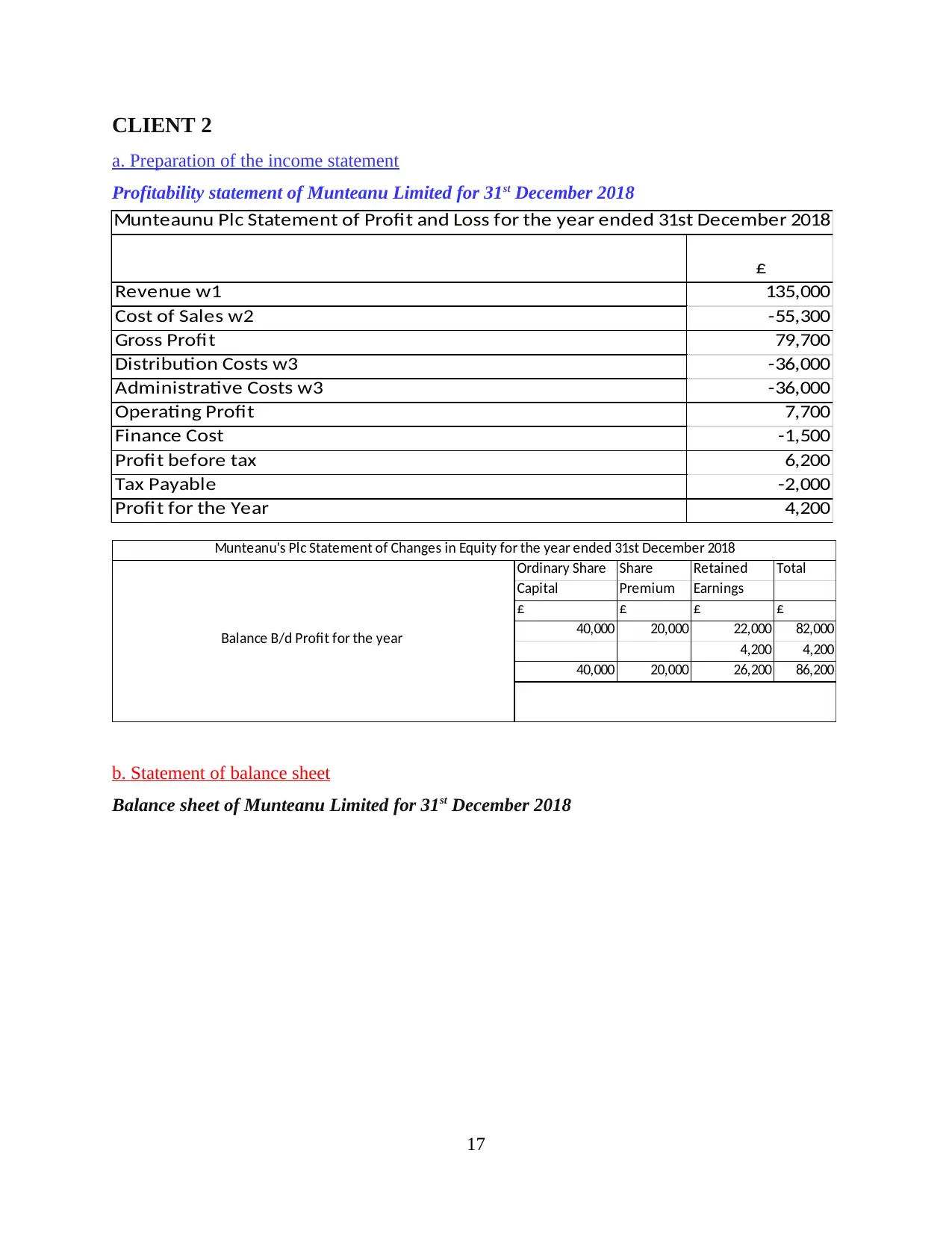
CLIENT 2
a. Preparation of the income statement
Profitability statement of Munteanu Limited for 31st December 2018
b. Statement of balance sheet
Balance sheet of Munteanu Limited for 31st December 2018
17
Revenue w1 135,000
Cost of Sales w2 -55,300
Gross Profit 79,700
Distribution Costs w3 -36,000
Administrative Costs w3 -36,000
Operating Profit 7,700
Finance Cost -1,500
Profit before tax 6,200
Tax Payable -2,000
Profit for the Year 4,200
Munteaunu Plc Statement of Profit and Loss for the year ended 31st December 2018
£
Ordinary Share Share Retained Total
Capital Premium Earnings
£ £ £ £
40,000 20,000 22,000 82,000
4,200 4,200
40,000 20,000 26,200 86,200
Munteanu's Plc Statement of Changes in Equity for the year ended 31st December 2018
Balance B/d Profit for the year
a. Preparation of the income statement
Profitability statement of Munteanu Limited for 31st December 2018
b. Statement of balance sheet
Balance sheet of Munteanu Limited for 31st December 2018
17
Revenue w1 135,000
Cost of Sales w2 -55,300
Gross Profit 79,700
Distribution Costs w3 -36,000
Administrative Costs w3 -36,000
Operating Profit 7,700
Finance Cost -1,500
Profit before tax 6,200
Tax Payable -2,000
Profit for the Year 4,200
Munteaunu Plc Statement of Profit and Loss for the year ended 31st December 2018
£
Ordinary Share Share Retained Total
Capital Premium Earnings
£ £ £ £
40,000 20,000 22,000 82,000
4,200 4,200
40,000 20,000 26,200 86,200
Munteanu's Plc Statement of Changes in Equity for the year ended 31st December 2018
Balance B/d Profit for the year
Paraphrase This Document
Need a fresh take? Get an instant paraphrase of this document with our AI Paraphraser
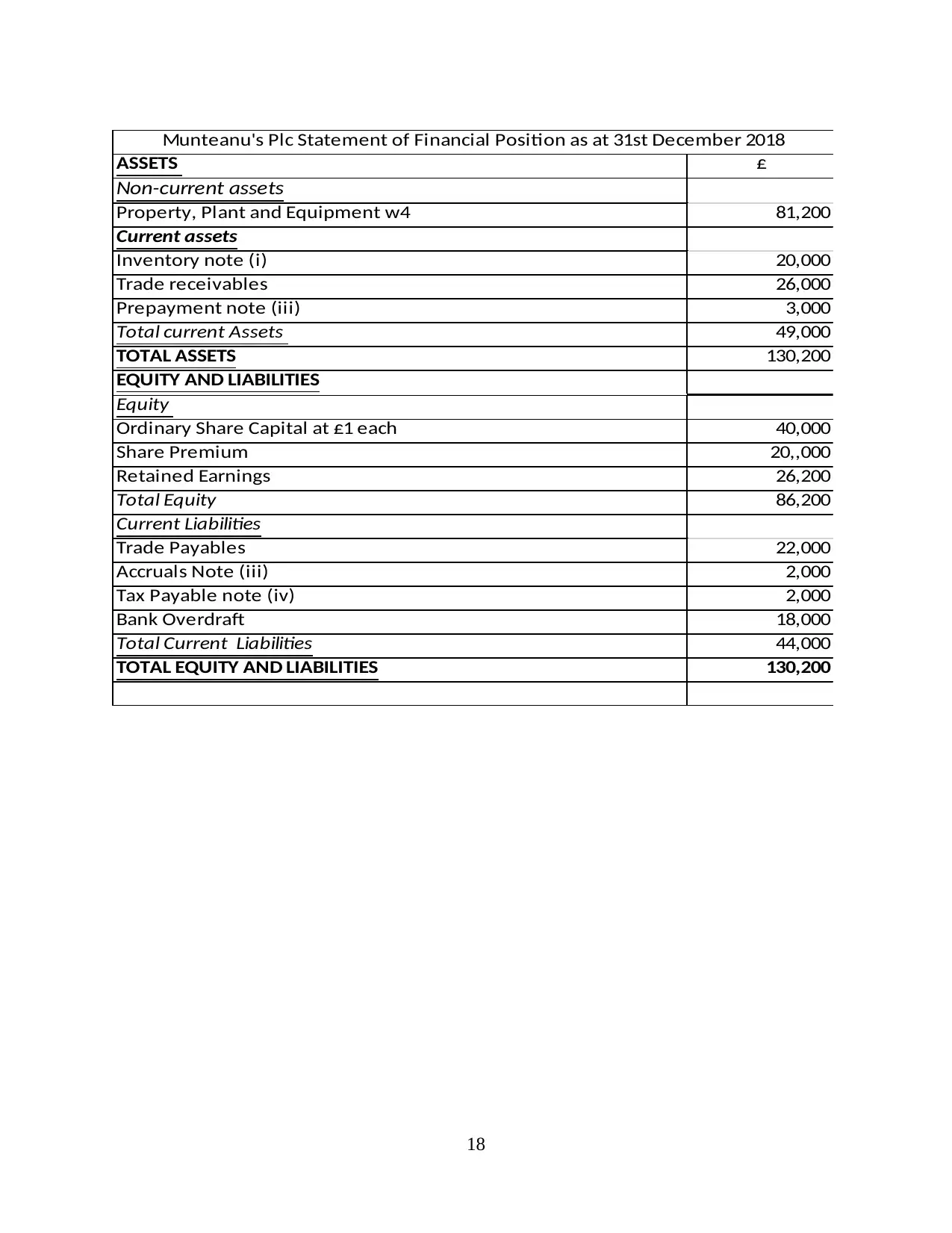
18
ASSETS £
Non-current assets
Property, Plant and Equipment w4 81,200
Current assets
Inventory note (i) 20,000
Trade receivables 26,000
Prepayment note (iii) 3,000
Total current Assets 49,000
TOTAL ASSETS 130,200
EQUITY AND LIABILITIES
Equity
Ordinary Share Capital at £1 each 40,000
Share Premium 20,,000
Retained Earnings 26,200
Total Equity 86,200
Current Liabilities
Trade Payables 22,000
Accruals Note (iii) 2,000
Tax Payable note (iv) 2,000
Bank Overdraft 18,000
Total Current Liabilities 44,000
TOTAL EQUITY AND LIABILITIES 130,200
Munteanu's Plc Statement of Financial Position as at 31st December 2018
ASSETS £
Non-current assets
Property, Plant and Equipment w4 81,200
Current assets
Inventory note (i) 20,000
Trade receivables 26,000
Prepayment note (iii) 3,000
Total current Assets 49,000
TOTAL ASSETS 130,200
EQUITY AND LIABILITIES
Equity
Ordinary Share Capital at £1 each 40,000
Share Premium 20,,000
Retained Earnings 26,200
Total Equity 86,200
Current Liabilities
Trade Payables 22,000
Accruals Note (iii) 2,000
Tax Payable note (iv) 2,000
Bank Overdraft 18,000
Total Current Liabilities 44,000
TOTAL EQUITY AND LIABILITIES 130,200
Munteanu's Plc Statement of Financial Position as at 31st December 2018
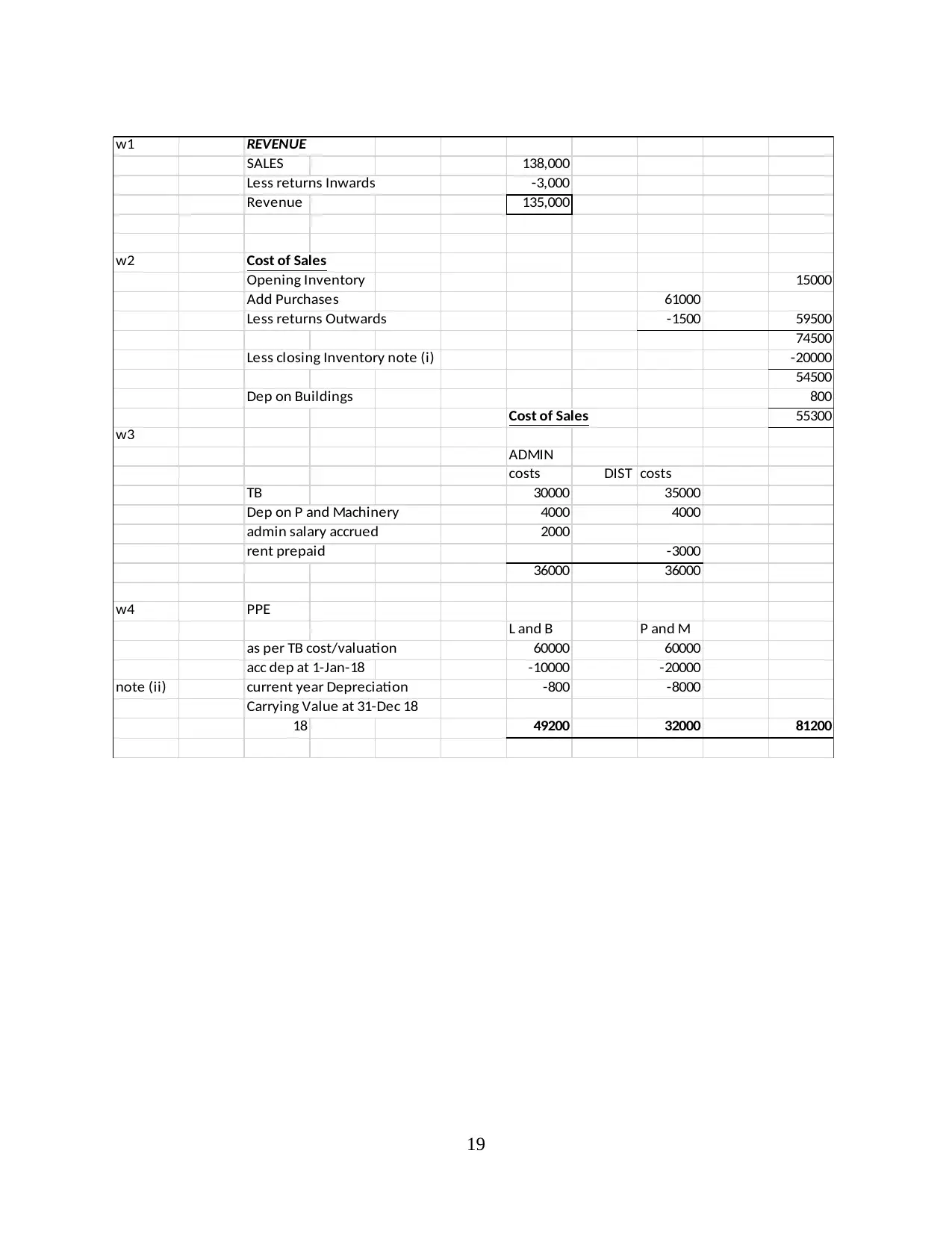
19
w1 REVENUE
SALES 138,000
Less returns Inwards -3,000
Revenue 135,000
w2 Cost of Sales
Opening Inventory 15000
Add Purchases 61000
Less returns Outwards -1500 59500
74500
Less closing Inventory note (i) -20000
54500
Dep on Buildings 800
Cost of Sales 55300
w3
ADMIN
costs DIST costs
TB 30000 35000
Dep on P and Machinery 4000 4000
admin salary accrued 2000
rent prepaid -3000
36000 36000
w4 PPE
L and B P and M
as per TB cost/valuation 60000 60000
acc dep at 1-Jan-18 -10000 -20000
note (ii) current year Depreciation -800 -8000
Carrying Value at 31-Dec 18
18 49200 32000 81200
w1 REVENUE
SALES 138,000
Less returns Inwards -3,000
Revenue 135,000
w2 Cost of Sales
Opening Inventory 15000
Add Purchases 61000
Less returns Outwards -1500 59500
74500
Less closing Inventory note (i) -20000
54500
Dep on Buildings 800
Cost of Sales 55300
w3
ADMIN
costs DIST costs
TB 30000 35000
Dep on P and Machinery 4000 4000
admin salary accrued 2000
rent prepaid -3000
36000 36000
w4 PPE
L and B P and M
as per TB cost/valuation 60000 60000
acc dep at 1-Jan-18 -10000 -20000
note (ii) current year Depreciation -800 -8000
Carrying Value at 31-Dec 18
18 49200 32000 81200
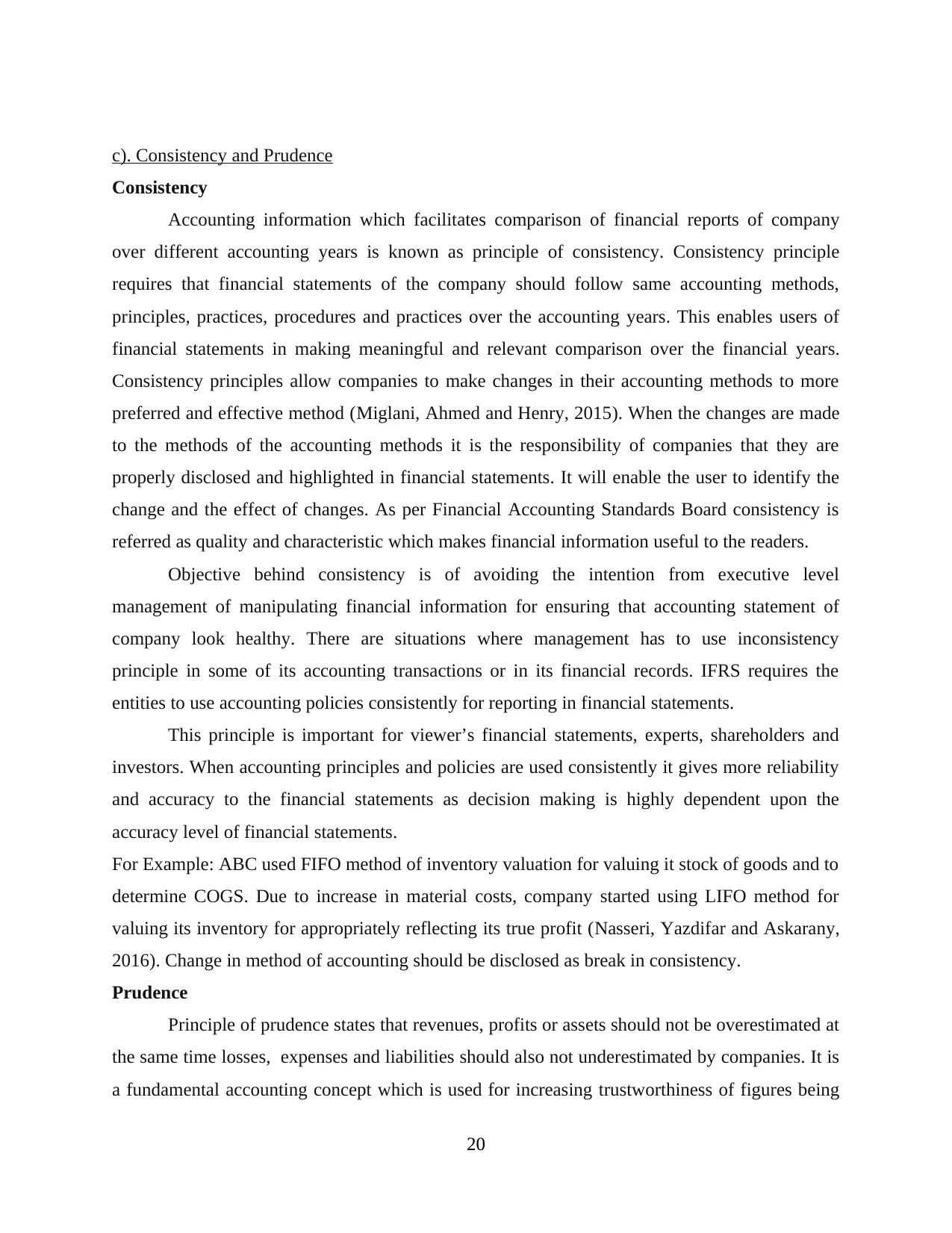
c). Consistency and Prudence
Consistency
Accounting information which facilitates comparison of financial reports of company
over different accounting years is known as principle of consistency. Consistency principle
requires that financial statements of the company should follow same accounting methods,
principles, practices, procedures and practices over the accounting years. This enables users of
financial statements in making meaningful and relevant comparison over the financial years.
Consistency principles allow companies to make changes in their accounting methods to more
preferred and effective method (Miglani, Ahmed and Henry, 2015). When the changes are made
to the methods of the accounting methods it is the responsibility of companies that they are
properly disclosed and highlighted in financial statements. It will enable the user to identify the
change and the effect of changes. As per Financial Accounting Standards Board consistency is
referred as quality and characteristic which makes financial information useful to the readers.
Objective behind consistency is of avoiding the intention from executive level
management of manipulating financial information for ensuring that accounting statement of
company look healthy. There are situations where management has to use inconsistency
principle in some of its accounting transactions or in its financial records. IFRS requires the
entities to use accounting policies consistently for reporting in financial statements.
This principle is important for viewer’s financial statements, experts, shareholders and
investors. When accounting principles and policies are used consistently it gives more reliability
and accuracy to the financial statements as decision making is highly dependent upon the
accuracy level of financial statements.
For Example: ABC used FIFO method of inventory valuation for valuing it stock of goods and to
determine COGS. Due to increase in material costs, company started using LIFO method for
valuing its inventory for appropriately reflecting its true profit (Nasseri, Yazdifar and Askarany,
2016). Change in method of accounting should be disclosed as break in consistency.
Prudence
Principle of prudence states that revenues, profits or assets should not be overestimated at
the same time losses, expenses and liabilities should also not underestimated by companies. It is
a fundamental accounting concept which is used for increasing trustworthiness of figures being
20
Consistency
Accounting information which facilitates comparison of financial reports of company
over different accounting years is known as principle of consistency. Consistency principle
requires that financial statements of the company should follow same accounting methods,
principles, practices, procedures and practices over the accounting years. This enables users of
financial statements in making meaningful and relevant comparison over the financial years.
Consistency principles allow companies to make changes in their accounting methods to more
preferred and effective method (Miglani, Ahmed and Henry, 2015). When the changes are made
to the methods of the accounting methods it is the responsibility of companies that they are
properly disclosed and highlighted in financial statements. It will enable the user to identify the
change and the effect of changes. As per Financial Accounting Standards Board consistency is
referred as quality and characteristic which makes financial information useful to the readers.
Objective behind consistency is of avoiding the intention from executive level
management of manipulating financial information for ensuring that accounting statement of
company look healthy. There are situations where management has to use inconsistency
principle in some of its accounting transactions or in its financial records. IFRS requires the
entities to use accounting policies consistently for reporting in financial statements.
This principle is important for viewer’s financial statements, experts, shareholders and
investors. When accounting principles and policies are used consistently it gives more reliability
and accuracy to the financial statements as decision making is highly dependent upon the
accuracy level of financial statements.
For Example: ABC used FIFO method of inventory valuation for valuing it stock of goods and to
determine COGS. Due to increase in material costs, company started using LIFO method for
valuing its inventory for appropriately reflecting its true profit (Nasseri, Yazdifar and Askarany,
2016). Change in method of accounting should be disclosed as break in consistency.
Prudence
Principle of prudence states that revenues, profits or assets should not be overestimated at
the same time losses, expenses and liabilities should also not underestimated by companies. It is
a fundamental accounting concept which is used for increasing trustworthiness of figures being
20
Secure Best Marks with AI Grader
Need help grading? Try our AI Grader for instant feedback on your assignments.
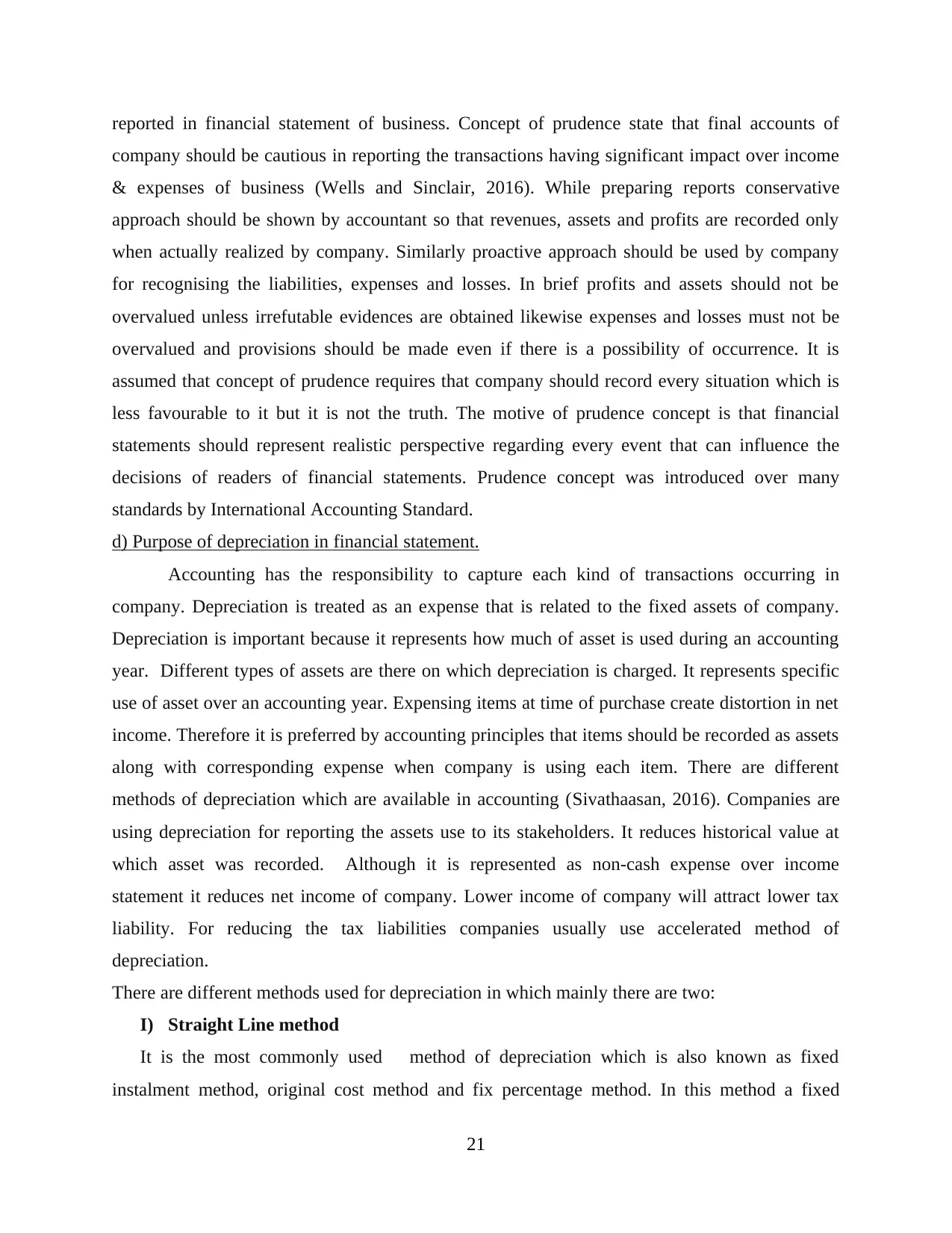
reported in financial statement of business. Concept of prudence state that final accounts of
company should be cautious in reporting the transactions having significant impact over income
& expenses of business (Wells and Sinclair, 2016). While preparing reports conservative
approach should be shown by accountant so that revenues, assets and profits are recorded only
when actually realized by company. Similarly proactive approach should be used by company
for recognising the liabilities, expenses and losses. In brief profits and assets should not be
overvalued unless irrefutable evidences are obtained likewise expenses and losses must not be
overvalued and provisions should be made even if there is a possibility of occurrence. It is
assumed that concept of prudence requires that company should record every situation which is
less favourable to it but it is not the truth. The motive of prudence concept is that financial
statements should represent realistic perspective regarding every event that can influence the
decisions of readers of financial statements. Prudence concept was introduced over many
standards by International Accounting Standard.
d) Purpose of depreciation in financial statement.
Accounting has the responsibility to capture each kind of transactions occurring in
company. Depreciation is treated as an expense that is related to the fixed assets of company.
Depreciation is important because it represents how much of asset is used during an accounting
year. Different types of assets are there on which depreciation is charged. It represents specific
use of asset over an accounting year. Expensing items at time of purchase create distortion in net
income. Therefore it is preferred by accounting principles that items should be recorded as assets
along with corresponding expense when company is using each item. There are different
methods of depreciation which are available in accounting (Sivathaasan, 2016). Companies are
using depreciation for reporting the assets use to its stakeholders. It reduces historical value at
which asset was recorded. Although it is represented as non-cash expense over income
statement it reduces net income of company. Lower income of company will attract lower tax
liability. For reducing the tax liabilities companies usually use accelerated method of
depreciation.
There are different methods used for depreciation in which mainly there are two:
I) Straight Line method
It is the most commonly used method of depreciation which is also known as fixed
instalment method, original cost method and fix percentage method. In this method a fixed
21
company should be cautious in reporting the transactions having significant impact over income
& expenses of business (Wells and Sinclair, 2016). While preparing reports conservative
approach should be shown by accountant so that revenues, assets and profits are recorded only
when actually realized by company. Similarly proactive approach should be used by company
for recognising the liabilities, expenses and losses. In brief profits and assets should not be
overvalued unless irrefutable evidences are obtained likewise expenses and losses must not be
overvalued and provisions should be made even if there is a possibility of occurrence. It is
assumed that concept of prudence requires that company should record every situation which is
less favourable to it but it is not the truth. The motive of prudence concept is that financial
statements should represent realistic perspective regarding every event that can influence the
decisions of readers of financial statements. Prudence concept was introduced over many
standards by International Accounting Standard.
d) Purpose of depreciation in financial statement.
Accounting has the responsibility to capture each kind of transactions occurring in
company. Depreciation is treated as an expense that is related to the fixed assets of company.
Depreciation is important because it represents how much of asset is used during an accounting
year. Different types of assets are there on which depreciation is charged. It represents specific
use of asset over an accounting year. Expensing items at time of purchase create distortion in net
income. Therefore it is preferred by accounting principles that items should be recorded as assets
along with corresponding expense when company is using each item. There are different
methods of depreciation which are available in accounting (Sivathaasan, 2016). Companies are
using depreciation for reporting the assets use to its stakeholders. It reduces historical value at
which asset was recorded. Although it is represented as non-cash expense over income
statement it reduces net income of company. Lower income of company will attract lower tax
liability. For reducing the tax liabilities companies usually use accelerated method of
depreciation.
There are different methods used for depreciation in which mainly there are two:
I) Straight Line method
It is the most commonly used method of depreciation which is also known as fixed
instalment method, original cost method and fix percentage method. In this method a fixed
21
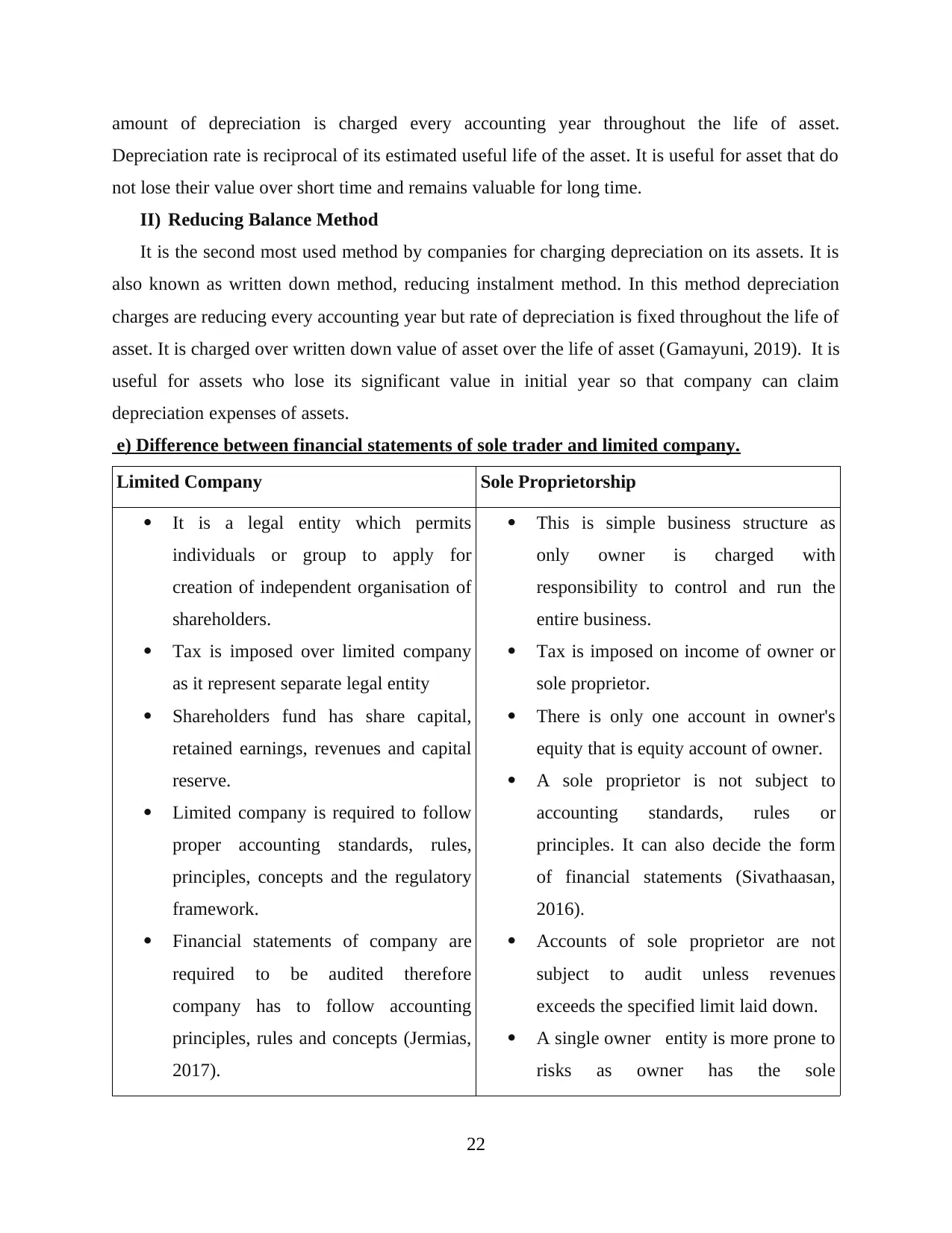
amount of depreciation is charged every accounting year throughout the life of asset.
Depreciation rate is reciprocal of its estimated useful life of the asset. It is useful for asset that do
not lose their value over short time and remains valuable for long time.
II) Reducing Balance Method
It is the second most used method by companies for charging depreciation on its assets. It is
also known as written down method, reducing instalment method. In this method depreciation
charges are reducing every accounting year but rate of depreciation is fixed throughout the life of
asset. It is charged over written down value of asset over the life of asset (Gamayuni, 2019). It is
useful for assets who lose its significant value in initial year so that company can claim
depreciation expenses of assets.
e) Difference between financial statements of sole trader and limited company.
Limited Company Sole Proprietorship
It is a legal entity which permits
individuals or group to apply for
creation of independent organisation of
shareholders.
Tax is imposed over limited company
as it represent separate legal entity
Shareholders fund has share capital,
retained earnings, revenues and capital
reserve.
Limited company is required to follow
proper accounting standards, rules,
principles, concepts and the regulatory
framework.
Financial statements of company are
required to be audited therefore
company has to follow accounting
principles, rules and concepts (Jermias,
2017).
This is simple business structure as
only owner is charged with
responsibility to control and run the
entire business.
Tax is imposed on income of owner or
sole proprietor.
There is only one account in owner's
equity that is equity account of owner.
A sole proprietor is not subject to
accounting standards, rules or
principles. It can also decide the form
of financial statements (Sivathaasan,
2016).
Accounts of sole proprietor are not
subject to audit unless revenues
exceeds the specified limit laid down.
A single owner entity is more prone to
risks as owner has the sole
22
Depreciation rate is reciprocal of its estimated useful life of the asset. It is useful for asset that do
not lose their value over short time and remains valuable for long time.
II) Reducing Balance Method
It is the second most used method by companies for charging depreciation on its assets. It is
also known as written down method, reducing instalment method. In this method depreciation
charges are reducing every accounting year but rate of depreciation is fixed throughout the life of
asset. It is charged over written down value of asset over the life of asset (Gamayuni, 2019). It is
useful for assets who lose its significant value in initial year so that company can claim
depreciation expenses of assets.
e) Difference between financial statements of sole trader and limited company.
Limited Company Sole Proprietorship
It is a legal entity which permits
individuals or group to apply for
creation of independent organisation of
shareholders.
Tax is imposed over limited company
as it represent separate legal entity
Shareholders fund has share capital,
retained earnings, revenues and capital
reserve.
Limited company is required to follow
proper accounting standards, rules,
principles, concepts and the regulatory
framework.
Financial statements of company are
required to be audited therefore
company has to follow accounting
principles, rules and concepts (Jermias,
2017).
This is simple business structure as
only owner is charged with
responsibility to control and run the
entire business.
Tax is imposed on income of owner or
sole proprietor.
There is only one account in owner's
equity that is equity account of owner.
A sole proprietor is not subject to
accounting standards, rules or
principles. It can also decide the form
of financial statements (Sivathaasan,
2016).
Accounts of sole proprietor are not
subject to audit unless revenues
exceeds the specified limit laid down.
A single owner entity is more prone to
risks as owner has the sole
22
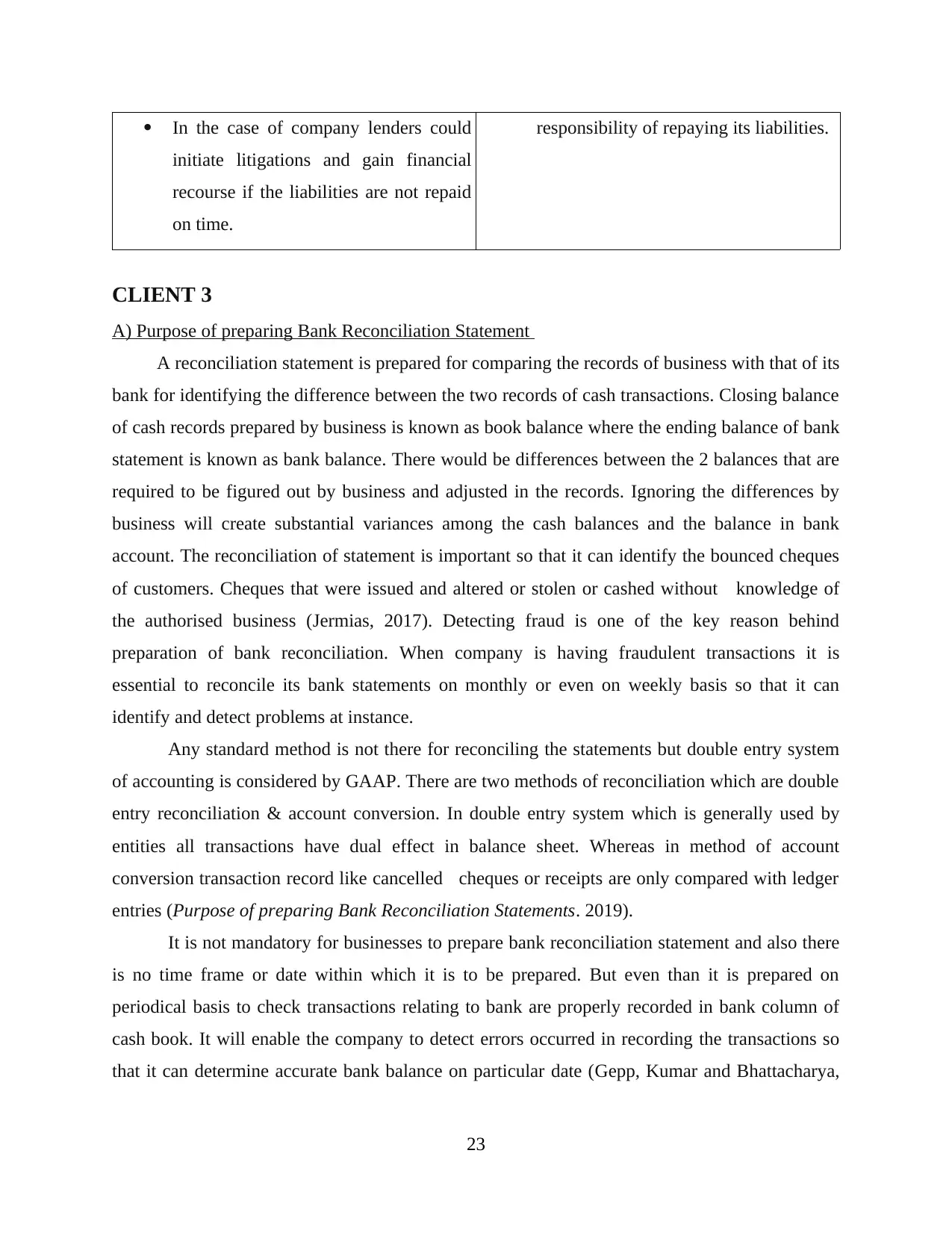
In the case of company lenders could
initiate litigations and gain financial
recourse if the liabilities are not repaid
on time.
responsibility of repaying its liabilities.
CLIENT 3
A) Purpose of preparing Bank Reconciliation Statement
A reconciliation statement is prepared for comparing the records of business with that of its
bank for identifying the difference between the two records of cash transactions. Closing balance
of cash records prepared by business is known as book balance where the ending balance of bank
statement is known as bank balance. There would be differences between the 2 balances that are
required to be figured out by business and adjusted in the records. Ignoring the differences by
business will create substantial variances among the cash balances and the balance in bank
account. The reconciliation of statement is important so that it can identify the bounced cheques
of customers. Cheques that were issued and altered or stolen or cashed without knowledge of
the authorised business (Jermias, 2017). Detecting fraud is one of the key reason behind
preparation of bank reconciliation. When company is having fraudulent transactions it is
essential to reconcile its bank statements on monthly or even on weekly basis so that it can
identify and detect problems at instance.
Any standard method is not there for reconciling the statements but double entry system
of accounting is considered by GAAP. There are two methods of reconciliation which are double
entry reconciliation & account conversion. In double entry system which is generally used by
entities all transactions have dual effect in balance sheet. Whereas in method of account
conversion transaction record like cancelled cheques or receipts are only compared with ledger
entries (Purpose of preparing Bank Reconciliation Statements. 2019).
It is not mandatory for businesses to prepare bank reconciliation statement and also there
is no time frame or date within which it is to be prepared. But even than it is prepared on
periodical basis to check transactions relating to bank are properly recorded in bank column of
cash book. It will enable the company to detect errors occurred in recording the transactions so
that it can determine accurate bank balance on particular date (Gepp, Kumar and Bhattacharya,
23
initiate litigations and gain financial
recourse if the liabilities are not repaid
on time.
responsibility of repaying its liabilities.
CLIENT 3
A) Purpose of preparing Bank Reconciliation Statement
A reconciliation statement is prepared for comparing the records of business with that of its
bank for identifying the difference between the two records of cash transactions. Closing balance
of cash records prepared by business is known as book balance where the ending balance of bank
statement is known as bank balance. There would be differences between the 2 balances that are
required to be figured out by business and adjusted in the records. Ignoring the differences by
business will create substantial variances among the cash balances and the balance in bank
account. The reconciliation of statement is important so that it can identify the bounced cheques
of customers. Cheques that were issued and altered or stolen or cashed without knowledge of
the authorised business (Jermias, 2017). Detecting fraud is one of the key reason behind
preparation of bank reconciliation. When company is having fraudulent transactions it is
essential to reconcile its bank statements on monthly or even on weekly basis so that it can
identify and detect problems at instance.
Any standard method is not there for reconciling the statements but double entry system
of accounting is considered by GAAP. There are two methods of reconciliation which are double
entry reconciliation & account conversion. In double entry system which is generally used by
entities all transactions have dual effect in balance sheet. Whereas in method of account
conversion transaction record like cancelled cheques or receipts are only compared with ledger
entries (Purpose of preparing Bank Reconciliation Statements. 2019).
It is not mandatory for businesses to prepare bank reconciliation statement and also there
is no time frame or date within which it is to be prepared. But even than it is prepared on
periodical basis to check transactions relating to bank are properly recorded in bank column of
cash book. It will enable the company to detect errors occurred in recording the transactions so
that it can determine accurate bank balance on particular date (Gepp, Kumar and Bhattacharya,
23
Paraphrase This Document
Need a fresh take? Get an instant paraphrase of this document with our AI Paraphraser
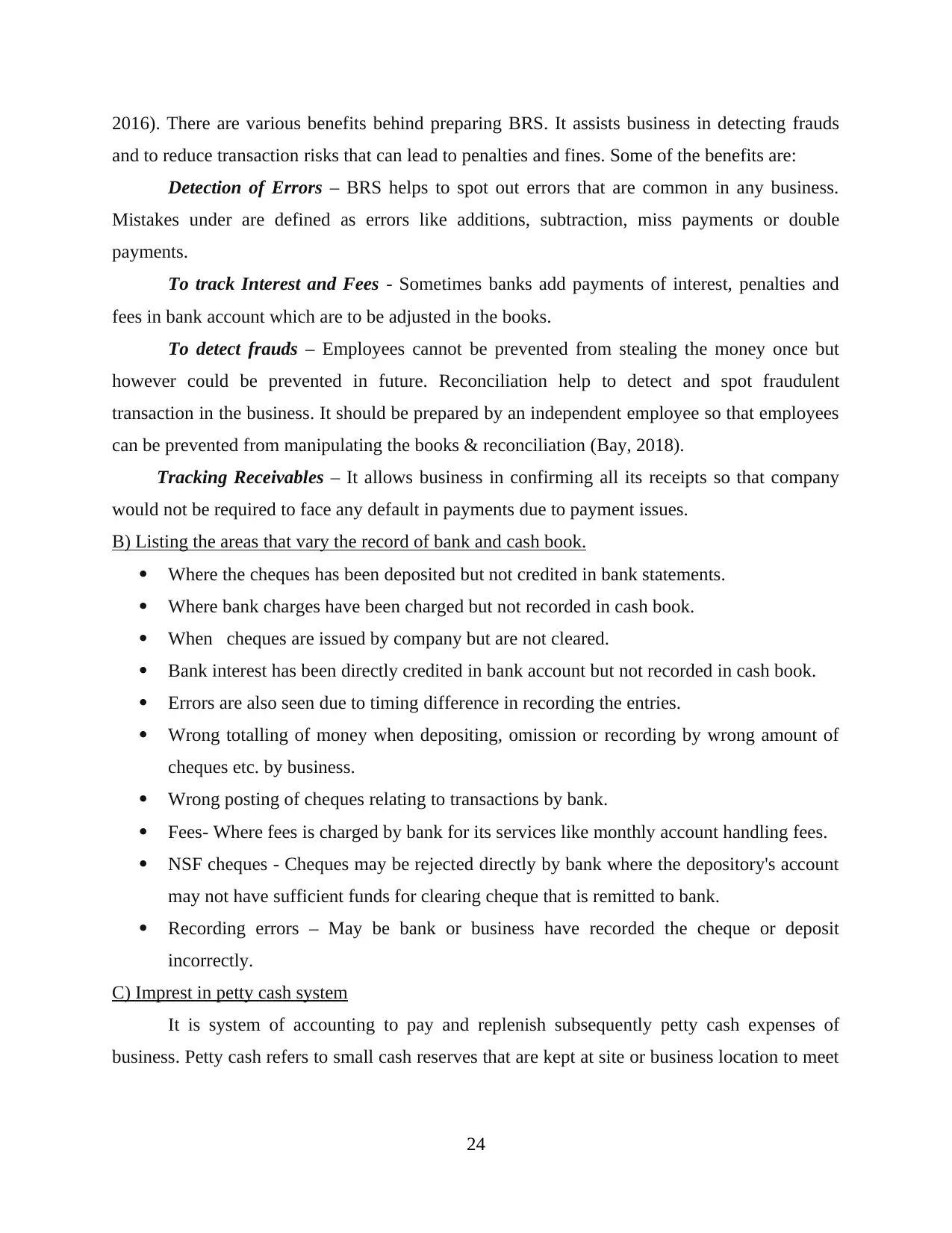
2016). There are various benefits behind preparing BRS. It assists business in detecting frauds
and to reduce transaction risks that can lead to penalties and fines. Some of the benefits are:
Detection of Errors – BRS helps to spot out errors that are common in any business.
Mistakes under are defined as errors like additions, subtraction, miss payments or double
payments.
To track Interest and Fees - Sometimes banks add payments of interest, penalties and
fees in bank account which are to be adjusted in the books.
To detect frauds – Employees cannot be prevented from stealing the money once but
however could be prevented in future. Reconciliation help to detect and spot fraudulent
transaction in the business. It should be prepared by an independent employee so that employees
can be prevented from manipulating the books & reconciliation (Bay, 2018).
Tracking Receivables – It allows business in confirming all its receipts so that company
would not be required to face any default in payments due to payment issues.
B) Listing the areas that vary the record of bank and cash book.
Where the cheques has been deposited but not credited in bank statements.
Where bank charges have been charged but not recorded in cash book.
When cheques are issued by company but are not cleared.
Bank interest has been directly credited in bank account but not recorded in cash book.
Errors are also seen due to timing difference in recording the entries.
Wrong totalling of money when depositing, omission or recording by wrong amount of
cheques etc. by business.
Wrong posting of cheques relating to transactions by bank.
Fees- Where fees is charged by bank for its services like monthly account handling fees.
NSF cheques - Cheques may be rejected directly by bank where the depository's account
may not have sufficient funds for clearing cheque that is remitted to bank.
Recording errors – May be bank or business have recorded the cheque or deposit
incorrectly.
C) Imprest in petty cash system
It is system of accounting to pay and replenish subsequently petty cash expenses of
business. Petty cash refers to small cash reserves that are kept at site or business location to meet
24
and to reduce transaction risks that can lead to penalties and fines. Some of the benefits are:
Detection of Errors – BRS helps to spot out errors that are common in any business.
Mistakes under are defined as errors like additions, subtraction, miss payments or double
payments.
To track Interest and Fees - Sometimes banks add payments of interest, penalties and
fees in bank account which are to be adjusted in the books.
To detect frauds – Employees cannot be prevented from stealing the money once but
however could be prevented in future. Reconciliation help to detect and spot fraudulent
transaction in the business. It should be prepared by an independent employee so that employees
can be prevented from manipulating the books & reconciliation (Bay, 2018).
Tracking Receivables – It allows business in confirming all its receipts so that company
would not be required to face any default in payments due to payment issues.
B) Listing the areas that vary the record of bank and cash book.
Where the cheques has been deposited but not credited in bank statements.
Where bank charges have been charged but not recorded in cash book.
When cheques are issued by company but are not cleared.
Bank interest has been directly credited in bank account but not recorded in cash book.
Errors are also seen due to timing difference in recording the entries.
Wrong totalling of money when depositing, omission or recording by wrong amount of
cheques etc. by business.
Wrong posting of cheques relating to transactions by bank.
Fees- Where fees is charged by bank for its services like monthly account handling fees.
NSF cheques - Cheques may be rejected directly by bank where the depository's account
may not have sufficient funds for clearing cheque that is remitted to bank.
Recording errors – May be bank or business have recorded the cheque or deposit
incorrectly.
C) Imprest in petty cash system
It is system of accounting to pay and replenish subsequently petty cash expenses of
business. Petty cash refers to small cash reserves that are kept at site or business location to meet
24
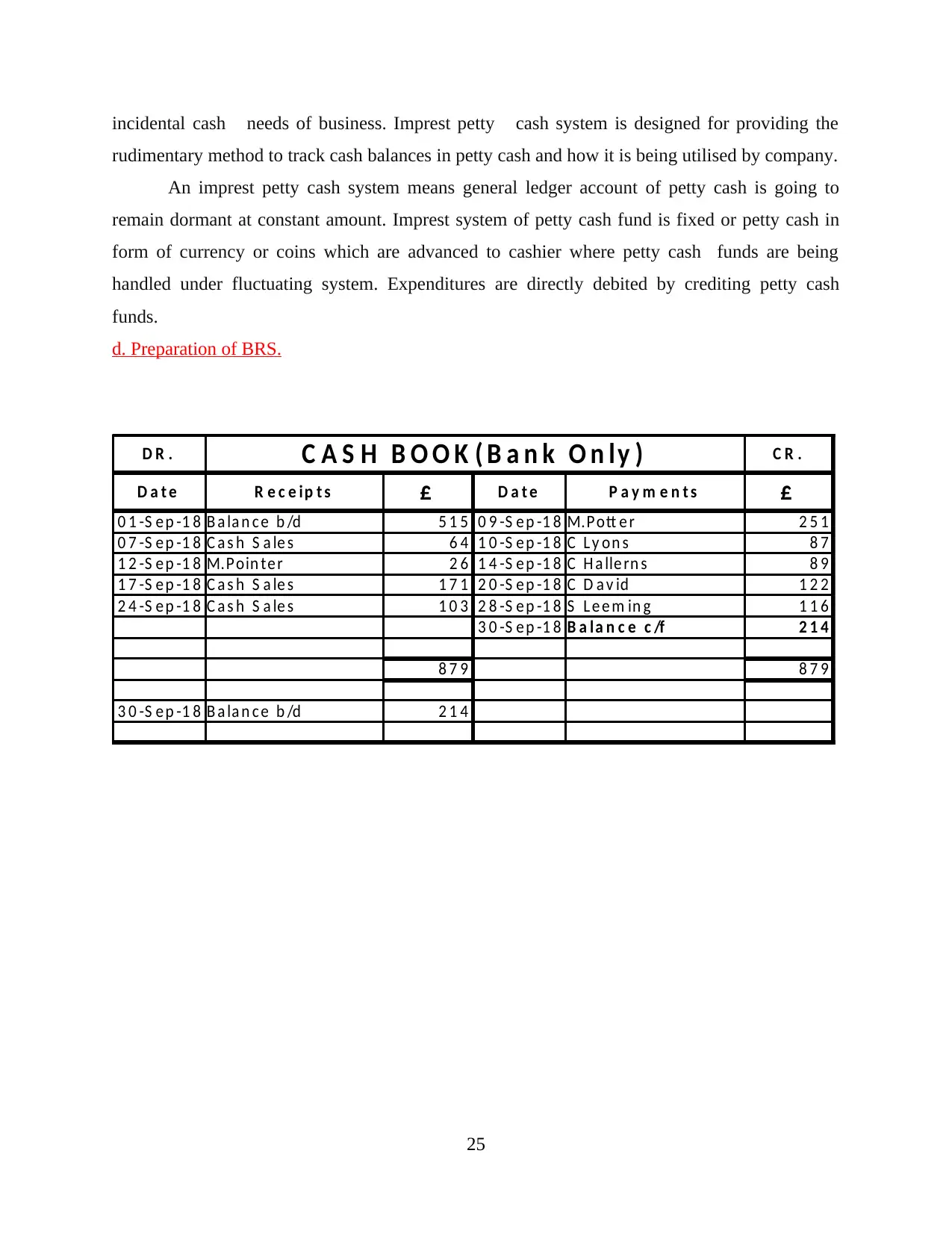
incidental cash needs of business. Imprest petty cash system is designed for providing the
rudimentary method to track cash balances in petty cash and how it is being utilised by company.
An imprest petty cash system means general ledger account of petty cash is going to
remain dormant at constant amount. Imprest system of petty cash fund is fixed or petty cash in
form of currency or coins which are advanced to cashier where petty cash funds are being
handled under fluctuating system. Expenditures are directly debited by crediting petty cash
funds.
d. Preparation of BRS.
D R . C A S H B O O K ( B a n k O n ly ) C R .
D a t e R e c e ip t s £ D a t e P a y m e n t s £
0 1 -S e p -1 8 B a la n c e b /d 5 1 5 0 9 -S e p -1 8 M.P ott e r 2 5 1
0 7 -S e p -1 8 C a s h S a le s 6 4 1 0 -S e p -1 8 C L y on s 8 7
1 2 -S e p -1 8 M.P oin te r 2 6 1 4 -S e p -1 8 C H a lle rn s 8 9
1 7 -S e p -1 8 C a s h S a le s 1 7 1 2 0 -S e p -1 8 C D a v id 1 2 2
2 4 -S e p -1 8 C a s h S a le s 1 0 3 2 8 -S e p -1 8 S L e e m in g 1 1 6
3 0 -S e p -1 8 B a la n c e c /f 2 1 4
8 7 9 8 7 9
3 0 -S e p -1 8 B a la n c e b /d 2 1 4
25
rudimentary method to track cash balances in petty cash and how it is being utilised by company.
An imprest petty cash system means general ledger account of petty cash is going to
remain dormant at constant amount. Imprest system of petty cash fund is fixed or petty cash in
form of currency or coins which are advanced to cashier where petty cash funds are being
handled under fluctuating system. Expenditures are directly debited by crediting petty cash
funds.
d. Preparation of BRS.
D R . C A S H B O O K ( B a n k O n ly ) C R .
D a t e R e c e ip t s £ D a t e P a y m e n t s £
0 1 -S e p -1 8 B a la n c e b /d 5 1 5 0 9 -S e p -1 8 M.P ott e r 2 5 1
0 7 -S e p -1 8 C a s h S a le s 6 4 1 0 -S e p -1 8 C L y on s 8 7
1 2 -S e p -1 8 M.P oin te r 2 6 1 4 -S e p -1 8 C H a lle rn s 8 9
1 7 -S e p -1 8 C a s h S a le s 1 7 1 2 0 -S e p -1 8 C D a v id 1 2 2
2 4 -S e p -1 8 C a s h S a le s 1 0 3 2 8 -S e p -1 8 S L e e m in g 1 1 6
3 0 -S e p -1 8 B a la n c e c /f 2 1 4
8 7 9 8 7 9
3 0 -S e p -1 8 B a la n c e b /d 2 1 4
25
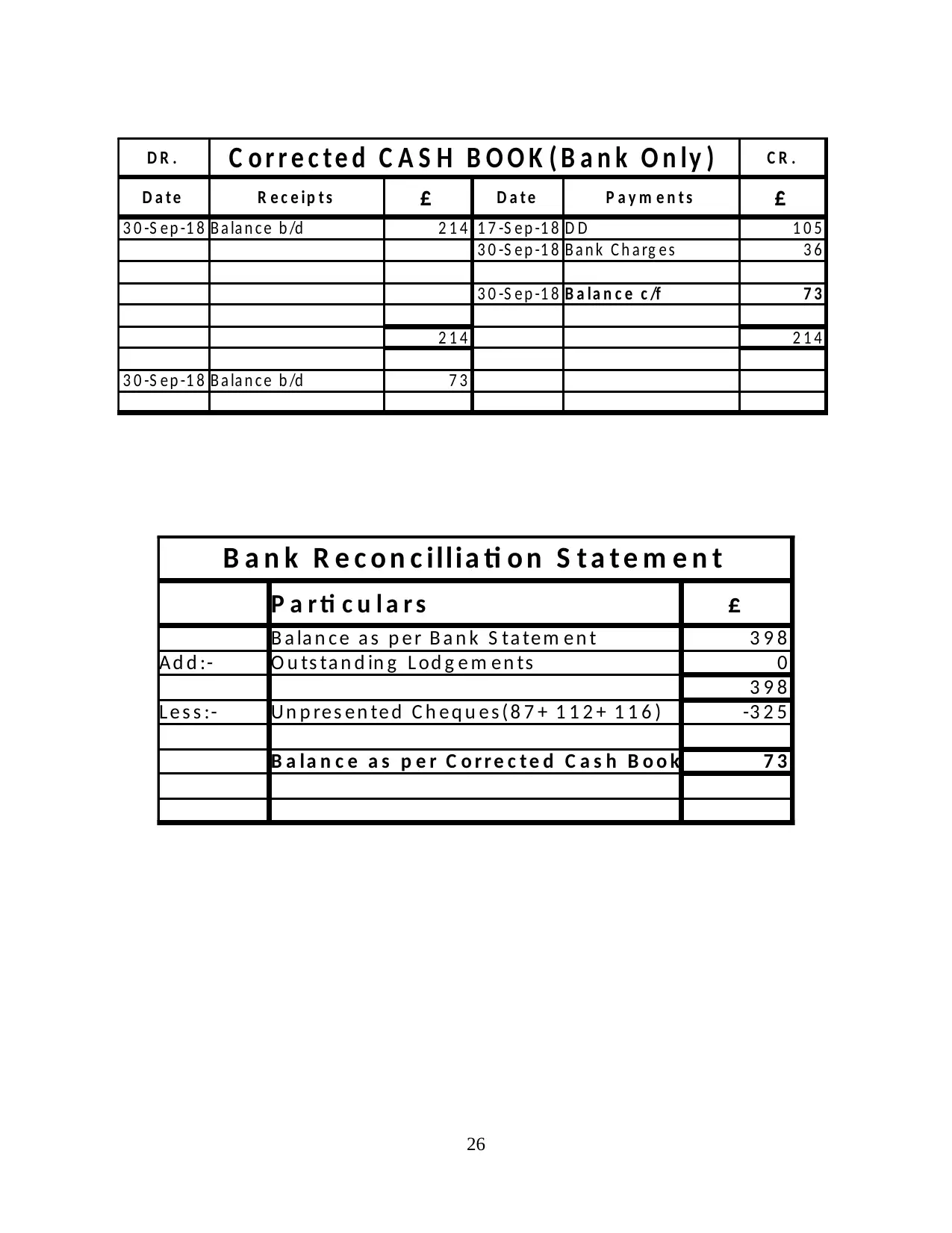
26
D R . C o r r e c t e d C A S H B O O K ( B a n k O n ly ) C R .
D a t e R e c e ip t s £ D a t e P a y m e n t s £
3 0 -S e p -1 8 B a la n c e b /d 2 1 4 1 7 -S e p -1 8 D D 1 0 5
3 0 -S e p -1 8 B a n k C h a rg e s 3 6
3 0 -S e p -1 8 B a la n c e c /f 7 3
2 1 4 2 1 4
3 0 -S e p -1 8 B a la n c e b /d 7 3
B a n k R e c o n c illia ti o n S t a t e m e n t
P a r ti c u l a r s £
B a la n c e a s p e r B a n k S ta te m e n t 3 9 8
A d d :- O u ts ta n d in g L od g e m e n ts 0
3 9 8
L e s s :- U n p re s e n te d C h e q u e s ( 8 7 + 1 1 2 + 1 1 6 ) -3 2 5
B a la n c e a s p e r C o r r e c t e d C a s h B o o k 7 3
D R . C o r r e c t e d C A S H B O O K ( B a n k O n ly ) C R .
D a t e R e c e ip t s £ D a t e P a y m e n t s £
3 0 -S e p -1 8 B a la n c e b /d 2 1 4 1 7 -S e p -1 8 D D 1 0 5
3 0 -S e p -1 8 B a n k C h a rg e s 3 6
3 0 -S e p -1 8 B a la n c e c /f 7 3
2 1 4 2 1 4
3 0 -S e p -1 8 B a la n c e b /d 7 3
B a n k R e c o n c illia ti o n S t a t e m e n t
P a r ti c u l a r s £
B a la n c e a s p e r B a n k S ta te m e n t 3 9 8
A d d :- O u ts ta n d in g L od g e m e n ts 0
3 9 8
L e s s :- U n p re s e n te d C h e q u e s ( 8 7 + 1 1 2 + 1 1 6 ) -3 2 5
B a la n c e a s p e r C o r r e c t e d C a s h B o o k 7 3
Secure Best Marks with AI Grader
Need help grading? Try our AI Grader for instant feedback on your assignments.
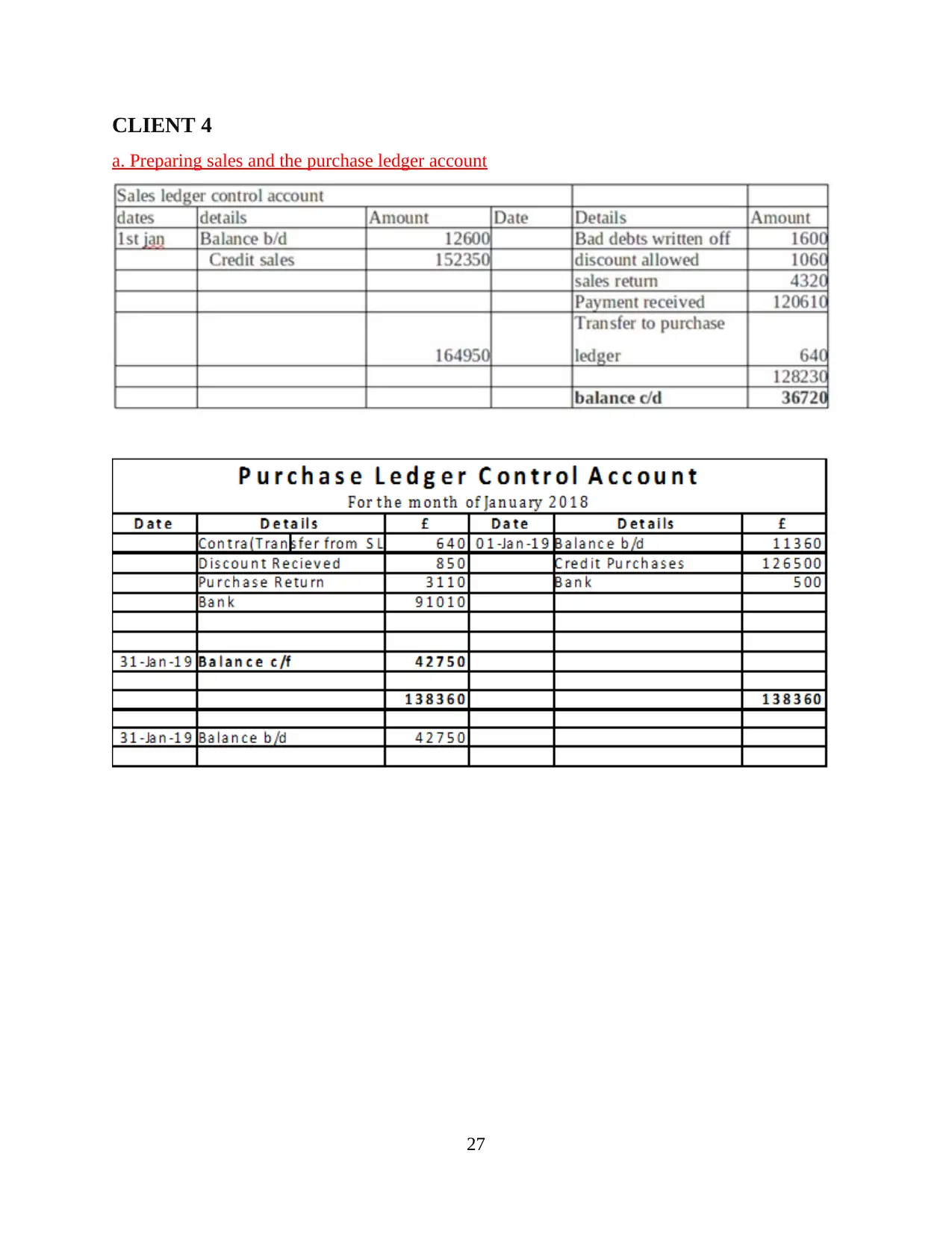
CLIENT 4
a. Preparing sales and the purchase ledger account
27
a. Preparing sales and the purchase ledger account
27
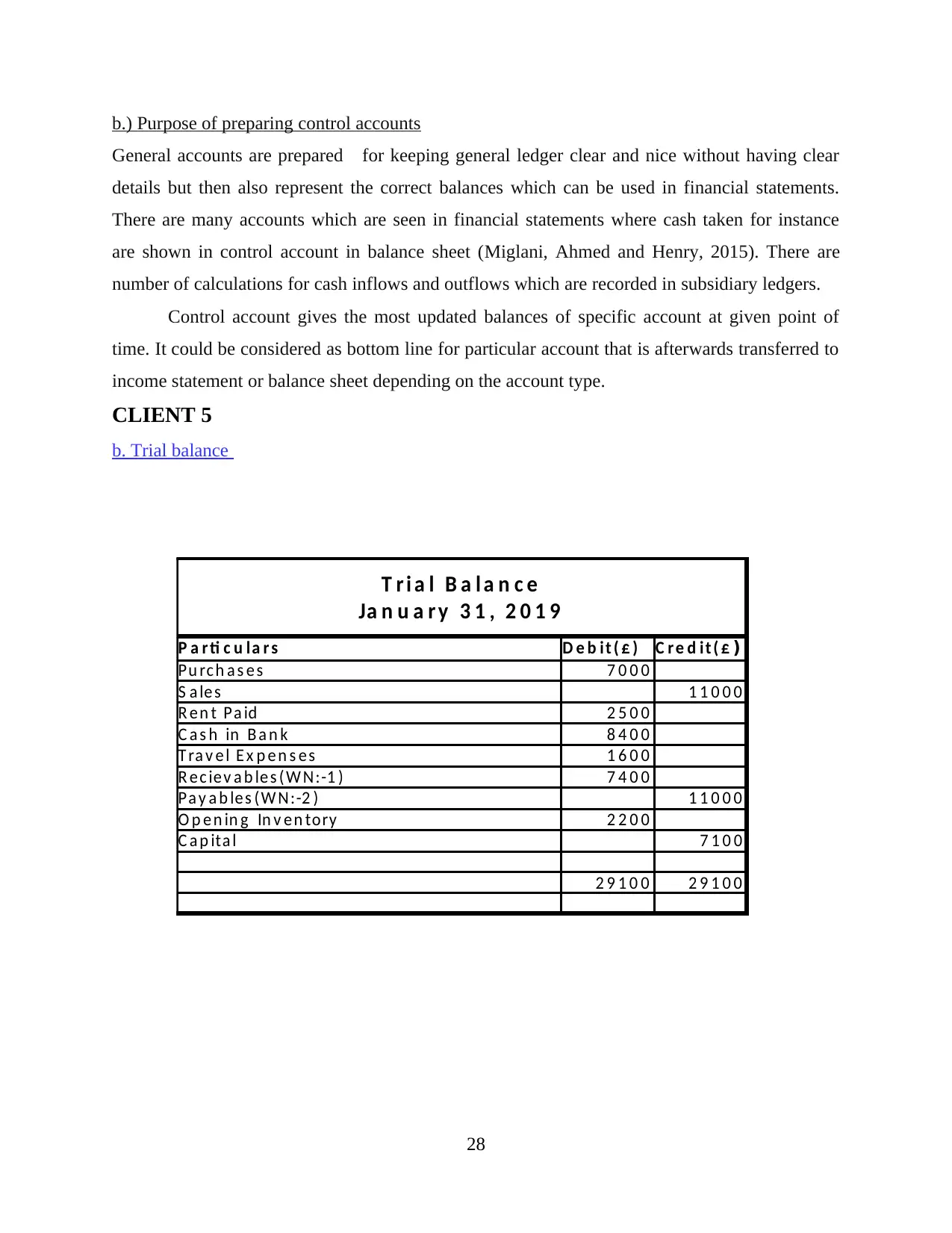
b.) Purpose of preparing control accounts
General accounts are prepared for keeping general ledger clear and nice without having clear
details but then also represent the correct balances which can be used in financial statements.
There are many accounts which are seen in financial statements where cash taken for instance
are shown in control account in balance sheet (Miglani, Ahmed and Henry, 2015). There are
number of calculations for cash inflows and outflows which are recorded in subsidiary ledgers.
Control account gives the most updated balances of specific account at given point of
time. It could be considered as bottom line for particular account that is afterwards transferred to
income statement or balance sheet depending on the account type.
CLIENT 5
b. Trial balance
28
P a r ti c u la r s D e b it ( £ )
Pu rc h a s e s 7 0 0 0
S a le s 1 1 0 0 0
R e n t Pa id 2 5 0 0
C a s h in B a n k 8 4 0 0
T ra v e l E x p e n s e s 1 6 0 0
R e c ie v a b le s ( W N:-1 ) 7 4 0 0
Pa y a b le s (W N:-2 ) 1 1 0 0 0
O p e n in g In v e n tory 2 2 0 0
C a p ita l 7 1 0 0
2 9 1 0 0 2 9 1 0 0
T r i a l B a l a n c e
Ja n u a r y 3 1 , 2 0 1 9
C r e d it ( £ )
General accounts are prepared for keeping general ledger clear and nice without having clear
details but then also represent the correct balances which can be used in financial statements.
There are many accounts which are seen in financial statements where cash taken for instance
are shown in control account in balance sheet (Miglani, Ahmed and Henry, 2015). There are
number of calculations for cash inflows and outflows which are recorded in subsidiary ledgers.
Control account gives the most updated balances of specific account at given point of
time. It could be considered as bottom line for particular account that is afterwards transferred to
income statement or balance sheet depending on the account type.
CLIENT 5
b. Trial balance
28
P a r ti c u la r s D e b it ( £ )
Pu rc h a s e s 7 0 0 0
S a le s 1 1 0 0 0
R e n t Pa id 2 5 0 0
C a s h in B a n k 8 4 0 0
T ra v e l E x p e n s e s 1 6 0 0
R e c ie v a b le s ( W N:-1 ) 7 4 0 0
Pa y a b le s (W N:-2 ) 1 1 0 0 0
O p e n in g In v e n tory 2 2 0 0
C a p ita l 7 1 0 0
2 9 1 0 0 2 9 1 0 0
T r i a l B a l a n c e
Ja n u a r y 3 1 , 2 0 1 9
C r e d it ( £ )
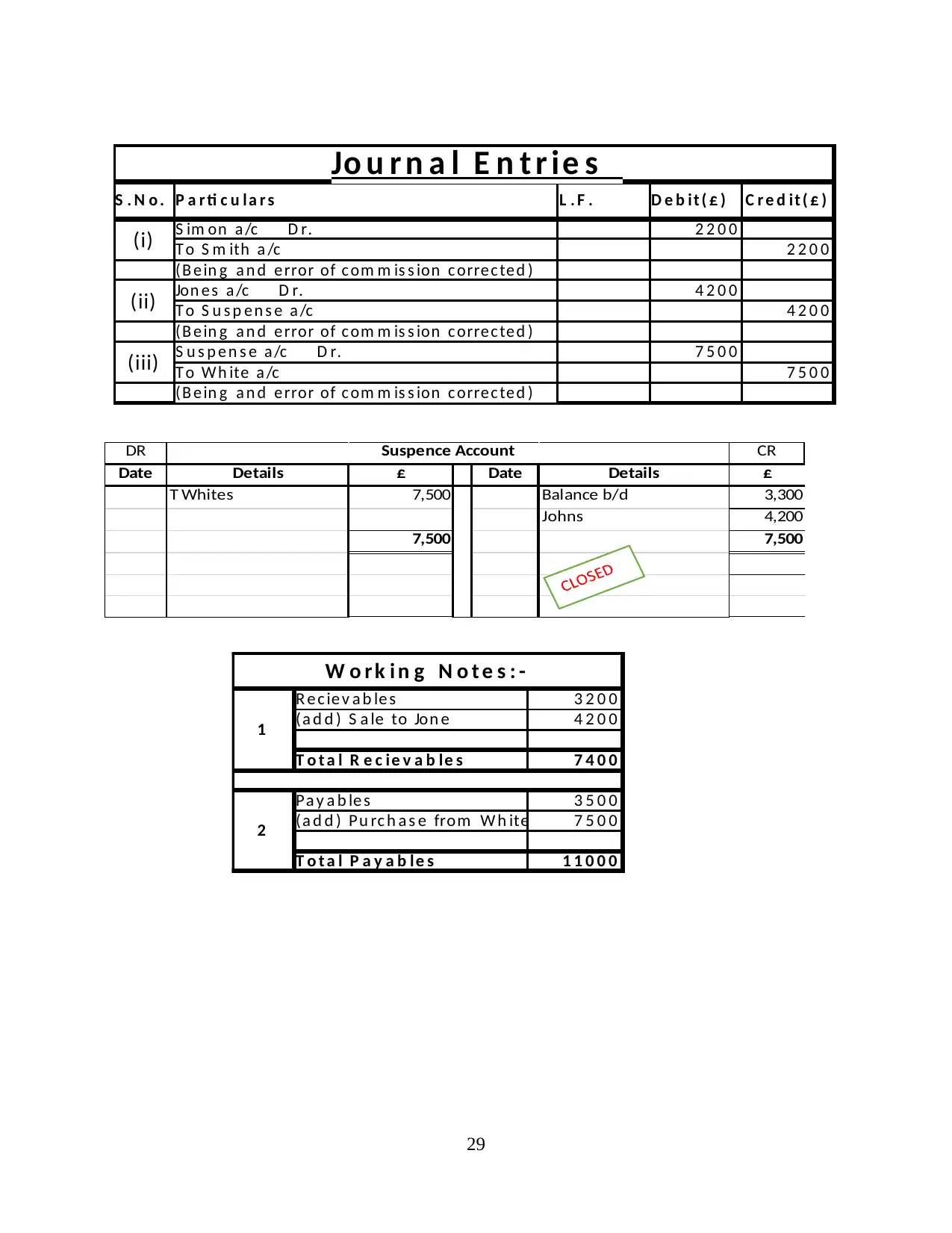
29
Jo u r n a l E n t r ie s
S . N o . P a r ti c u la r s L . F . D e b it ( £ ) C r e d it ( £ )
(i) S im on a /c D r. 2 2 0 0
T o S m ith a /c 2 2 0 0
(B e in g a n d e rror of c om m is s ion c orre c te d )
(ii) Jon e s a /c D r. 4 2 0 0
T o S u s p e n s e a /c 4 2 0 0
(B e in g a n d e rror of c om m is s ion c orre c te d )
(iii) S u s p e n s e a /c D r. 7 5 0 0
T o W h ite a /c 7 5 0 0
(B e in g a n d e rror of c om m is s ion c orre c te d )
DR CR
Date Details £ Date Details £
T Whites 7,500 Balance b/d 3,300
Johns 4,200
7,500 7,500
Suspence Account
W o r k i n g N o t e s : -
1
R e c ie v a b le s 3 2 0 0
(a d d ) S a le to Jon e 4 2 0 0
T o t a l R e c ie v a b le s 7 4 0 0
2
Pa y a b le s 3 5 0 0
(a d d ) Pu rc h a s e from W h ite 7 5 0 0
T o t a l P a y a b le s 1 1 0 0 0
Jo u r n a l E n t r ie s
S . N o . P a r ti c u la r s L . F . D e b it ( £ ) C r e d it ( £ )
(i) S im on a /c D r. 2 2 0 0
T o S m ith a /c 2 2 0 0
(B e in g a n d e rror of c om m is s ion c orre c te d )
(ii) Jon e s a /c D r. 4 2 0 0
T o S u s p e n s e a /c 4 2 0 0
(B e in g a n d e rror of c om m is s ion c orre c te d )
(iii) S u s p e n s e a /c D r. 7 5 0 0
T o W h ite a /c 7 5 0 0
(B e in g a n d e rror of c om m is s ion c orre c te d )
DR CR
Date Details £ Date Details £
T Whites 7,500 Balance b/d 3,300
Johns 4,200
7,500 7,500
Suspence Account
W o r k i n g N o t e s : -
1
R e c ie v a b le s 3 2 0 0
(a d d ) S a le to Jon e 4 2 0 0
T o t a l R e c ie v a b le s 7 4 0 0
2
Pa y a b le s 3 5 0 0
(a d d ) Pu rc h a s e from W h ite 7 5 0 0
T o t a l P a y a b le s 1 1 0 0 0
Paraphrase This Document
Need a fresh take? Get an instant paraphrase of this document with our AI Paraphraser
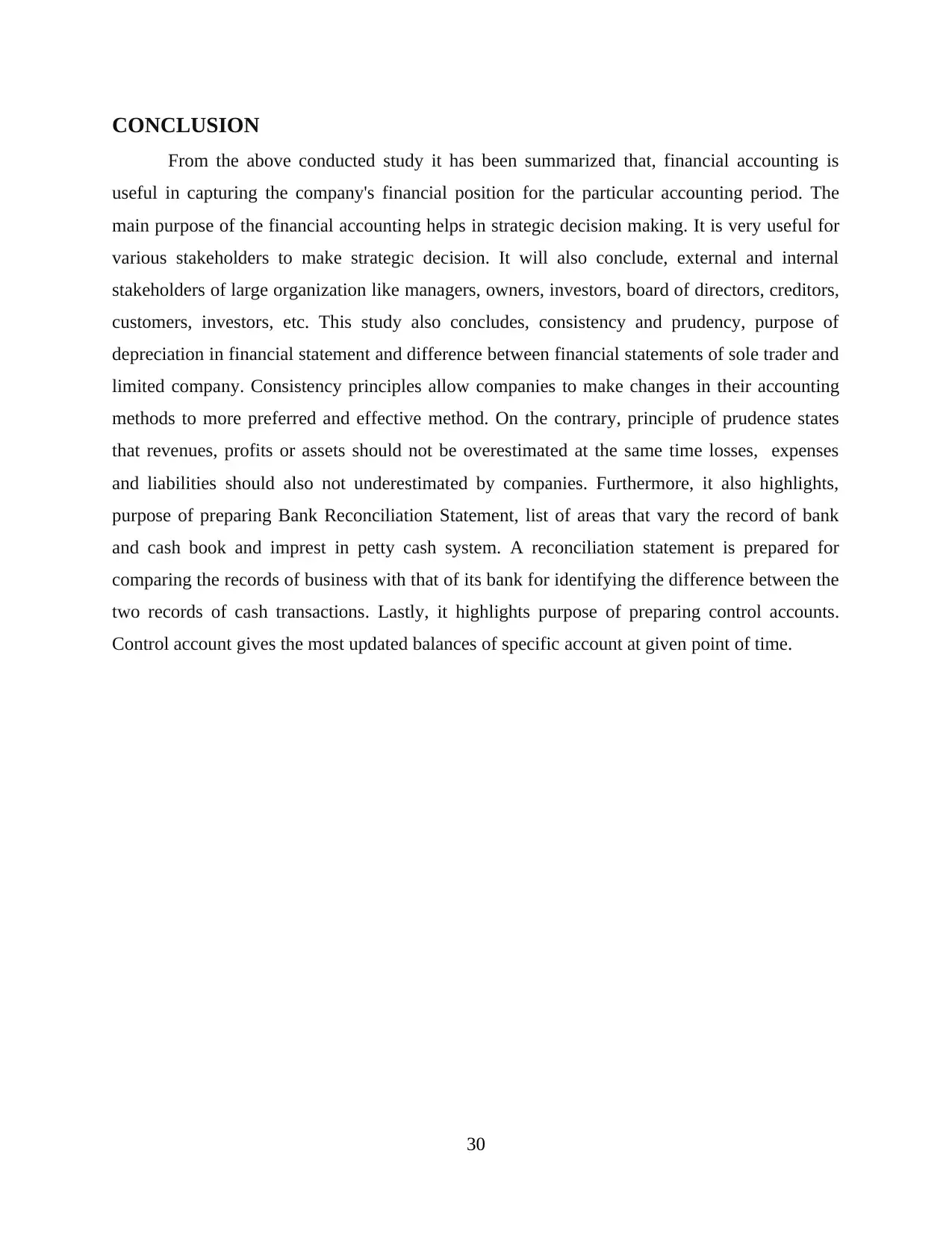
CONCLUSION
From the above conducted study it has been summarized that, financial accounting is
useful in capturing the company's financial position for the particular accounting period. The
main purpose of the financial accounting helps in strategic decision making. It is very useful for
various stakeholders to make strategic decision. It will also conclude, external and internal
stakeholders of large organization like managers, owners, investors, board of directors, creditors,
customers, investors, etc. This study also concludes, consistency and prudency, purpose of
depreciation in financial statement and difference between financial statements of sole trader and
limited company. Consistency principles allow companies to make changes in their accounting
methods to more preferred and effective method. On the contrary, principle of prudence states
that revenues, profits or assets should not be overestimated at the same time losses, expenses
and liabilities should also not underestimated by companies. Furthermore, it also highlights,
purpose of preparing Bank Reconciliation Statement, list of areas that vary the record of bank
and cash book and imprest in petty cash system. A reconciliation statement is prepared for
comparing the records of business with that of its bank for identifying the difference between the
two records of cash transactions. Lastly, it highlights purpose of preparing control accounts.
Control account gives the most updated balances of specific account at given point of time.
30
From the above conducted study it has been summarized that, financial accounting is
useful in capturing the company's financial position for the particular accounting period. The
main purpose of the financial accounting helps in strategic decision making. It is very useful for
various stakeholders to make strategic decision. It will also conclude, external and internal
stakeholders of large organization like managers, owners, investors, board of directors, creditors,
customers, investors, etc. This study also concludes, consistency and prudency, purpose of
depreciation in financial statement and difference between financial statements of sole trader and
limited company. Consistency principles allow companies to make changes in their accounting
methods to more preferred and effective method. On the contrary, principle of prudence states
that revenues, profits or assets should not be overestimated at the same time losses, expenses
and liabilities should also not underestimated by companies. Furthermore, it also highlights,
purpose of preparing Bank Reconciliation Statement, list of areas that vary the record of bank
and cash book and imprest in petty cash system. A reconciliation statement is prepared for
comparing the records of business with that of its bank for identifying the difference between the
two records of cash transactions. Lastly, it highlights purpose of preparing control accounts.
Control account gives the most updated balances of specific account at given point of time.
30
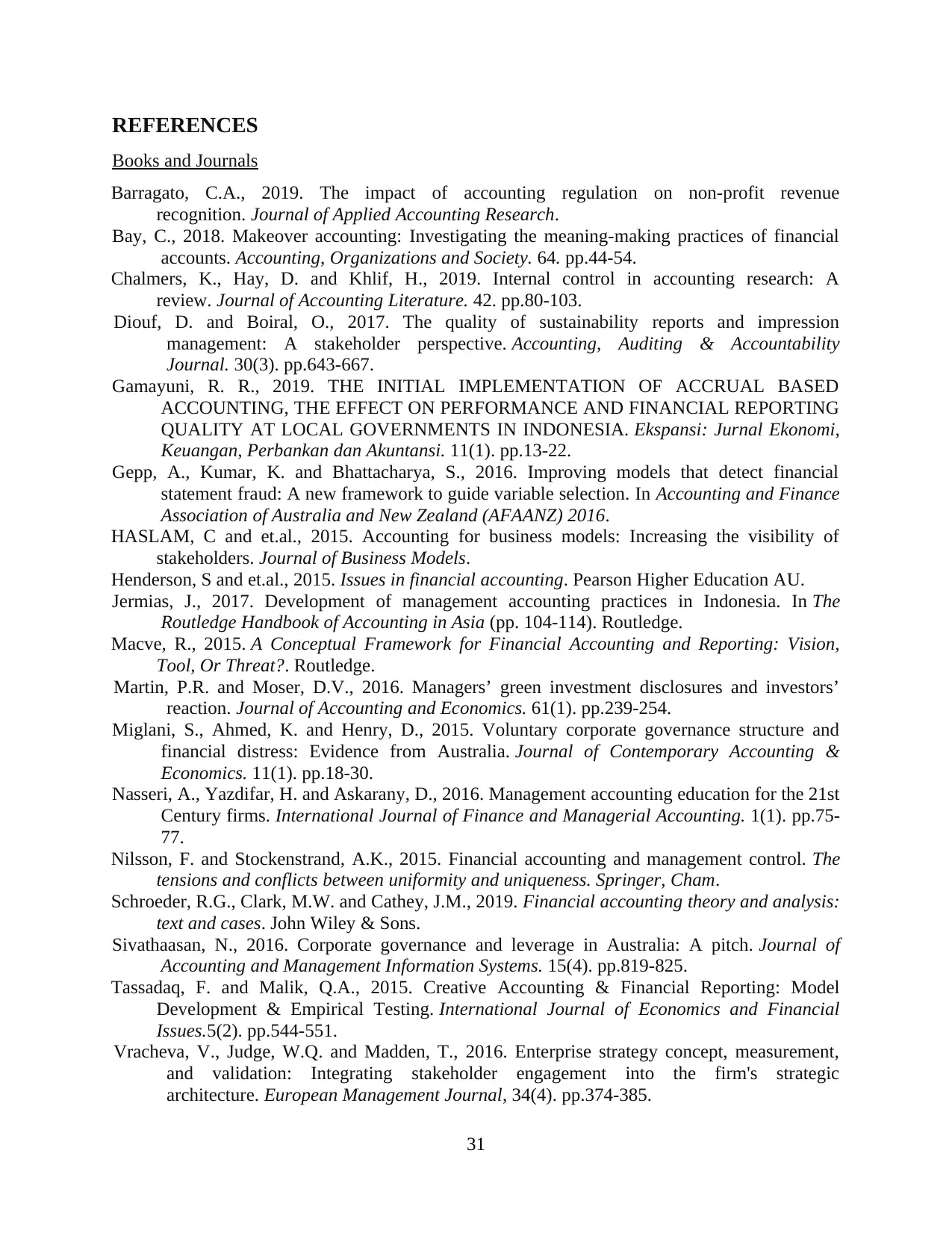
REFERENCES
Books and Journals
Barragato, C.A., 2019. The impact of accounting regulation on non-profit revenue
recognition. Journal of Applied Accounting Research.
Bay, C., 2018. Makeover accounting: Investigating the meaning-making practices of financial
accounts. Accounting, Organizations and Society. 64. pp.44-54.
Chalmers, K., Hay, D. and Khlif, H., 2019. Internal control in accounting research: A
review. Journal of Accounting Literature. 42. pp.80-103.
Diouf, D. and Boiral, O., 2017. The quality of sustainability reports and impression
management: A stakeholder perspective. Accounting, Auditing & Accountability
Journal. 30(3). pp.643-667.
Gamayuni, R. R., 2019. THE INITIAL IMPLEMENTATION OF ACCRUAL BASED
ACCOUNTING, THE EFFECT ON PERFORMANCE AND FINANCIAL REPORTING
QUALITY AT LOCAL GOVERNMENTS IN INDONESIA. Ekspansi: Jurnal Ekonomi,
Keuangan, Perbankan dan Akuntansi. 11(1). pp.13-22.
Gepp, A., Kumar, K. and Bhattacharya, S., 2016. Improving models that detect financial
statement fraud: A new framework to guide variable selection. In Accounting and Finance
Association of Australia and New Zealand (AFAANZ) 2016.
HASLAM, C and et.al., 2015. Accounting for business models: Increasing the visibility of
stakeholders. Journal of Business Models.
Henderson, S and et.al., 2015. Issues in financial accounting. Pearson Higher Education AU.
Jermias, J., 2017. Development of management accounting practices in Indonesia. In The
Routledge Handbook of Accounting in Asia (pp. 104-114). Routledge.
Macve, R., 2015. A Conceptual Framework for Financial Accounting and Reporting: Vision,
Tool, Or Threat?. Routledge.
Martin, P.R. and Moser, D.V., 2016. Managers’ green investment disclosures and investors’
reaction. Journal of Accounting and Economics. 61(1). pp.239-254.
Miglani, S., Ahmed, K. and Henry, D., 2015. Voluntary corporate governance structure and
financial distress: Evidence from Australia. Journal of Contemporary Accounting &
Economics. 11(1). pp.18-30.
Nasseri, A., Yazdifar, H. and Askarany, D., 2016. Management accounting education for the 21st
Century firms. International Journal of Finance and Managerial Accounting. 1(1). pp.75-
77.
Nilsson, F. and Stockenstrand, A.K., 2015. Financial accounting and management control. The
tensions and conflicts between uniformity and uniqueness. Springer, Cham.
Schroeder, R.G., Clark, M.W. and Cathey, J.M., 2019. Financial accounting theory and analysis:
text and cases. John Wiley & Sons.
Sivathaasan, N., 2016. Corporate governance and leverage in Australia: A pitch. Journal of
Accounting and Management Information Systems. 15(4). pp.819-825.
Tassadaq, F. and Malik, Q.A., 2015. Creative Accounting & Financial Reporting: Model
Development & Empirical Testing. International Journal of Economics and Financial
Issues.5(2). pp.544-551.
Vracheva, V., Judge, W.Q. and Madden, T., 2016. Enterprise strategy concept, measurement,
and validation: Integrating stakeholder engagement into the firm's strategic
architecture. European Management Journal, 34(4). pp.374-385.
31
Books and Journals
Barragato, C.A., 2019. The impact of accounting regulation on non-profit revenue
recognition. Journal of Applied Accounting Research.
Bay, C., 2018. Makeover accounting: Investigating the meaning-making practices of financial
accounts. Accounting, Organizations and Society. 64. pp.44-54.
Chalmers, K., Hay, D. and Khlif, H., 2019. Internal control in accounting research: A
review. Journal of Accounting Literature. 42. pp.80-103.
Diouf, D. and Boiral, O., 2017. The quality of sustainability reports and impression
management: A stakeholder perspective. Accounting, Auditing & Accountability
Journal. 30(3). pp.643-667.
Gamayuni, R. R., 2019. THE INITIAL IMPLEMENTATION OF ACCRUAL BASED
ACCOUNTING, THE EFFECT ON PERFORMANCE AND FINANCIAL REPORTING
QUALITY AT LOCAL GOVERNMENTS IN INDONESIA. Ekspansi: Jurnal Ekonomi,
Keuangan, Perbankan dan Akuntansi. 11(1). pp.13-22.
Gepp, A., Kumar, K. and Bhattacharya, S., 2016. Improving models that detect financial
statement fraud: A new framework to guide variable selection. In Accounting and Finance
Association of Australia and New Zealand (AFAANZ) 2016.
HASLAM, C and et.al., 2015. Accounting for business models: Increasing the visibility of
stakeholders. Journal of Business Models.
Henderson, S and et.al., 2015. Issues in financial accounting. Pearson Higher Education AU.
Jermias, J., 2017. Development of management accounting practices in Indonesia. In The
Routledge Handbook of Accounting in Asia (pp. 104-114). Routledge.
Macve, R., 2015. A Conceptual Framework for Financial Accounting and Reporting: Vision,
Tool, Or Threat?. Routledge.
Martin, P.R. and Moser, D.V., 2016. Managers’ green investment disclosures and investors’
reaction. Journal of Accounting and Economics. 61(1). pp.239-254.
Miglani, S., Ahmed, K. and Henry, D., 2015. Voluntary corporate governance structure and
financial distress: Evidence from Australia. Journal of Contemporary Accounting &
Economics. 11(1). pp.18-30.
Nasseri, A., Yazdifar, H. and Askarany, D., 2016. Management accounting education for the 21st
Century firms. International Journal of Finance and Managerial Accounting. 1(1). pp.75-
77.
Nilsson, F. and Stockenstrand, A.K., 2015. Financial accounting and management control. The
tensions and conflicts between uniformity and uniqueness. Springer, Cham.
Schroeder, R.G., Clark, M.W. and Cathey, J.M., 2019. Financial accounting theory and analysis:
text and cases. John Wiley & Sons.
Sivathaasan, N., 2016. Corporate governance and leverage in Australia: A pitch. Journal of
Accounting and Management Information Systems. 15(4). pp.819-825.
Tassadaq, F. and Malik, Q.A., 2015. Creative Accounting & Financial Reporting: Model
Development & Empirical Testing. International Journal of Economics and Financial
Issues.5(2). pp.544-551.
Vracheva, V., Judge, W.Q. and Madden, T., 2016. Enterprise strategy concept, measurement,
and validation: Integrating stakeholder engagement into the firm's strategic
architecture. European Management Journal, 34(4). pp.374-385.
31
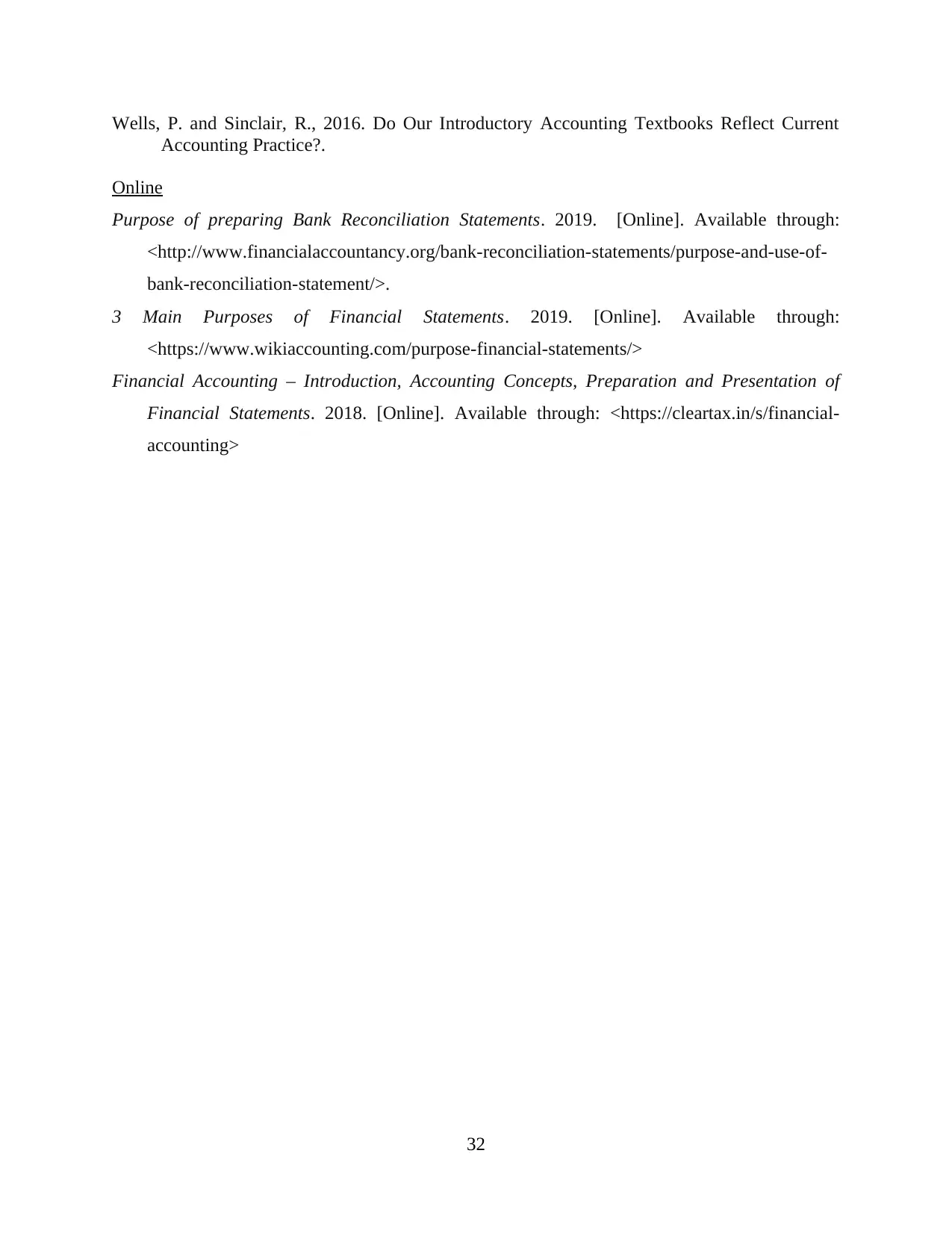
Wells, P. and Sinclair, R., 2016. Do Our Introductory Accounting Textbooks Reflect Current
Accounting Practice?.
Online
Purpose of preparing Bank Reconciliation Statements. 2019. [Online]. Available through:
<http://www.financialaccountancy.org/bank-reconciliation-statements/purpose-and-use-of-
bank-reconciliation-statement/>.
3 Main Purposes of Financial Statements. 2019. [Online]. Available through:
<https://www.wikiaccounting.com/purpose-financial-statements/>
Financial Accounting – Introduction, Accounting Concepts, Preparation and Presentation of
Financial Statements. 2018. [Online]. Available through: <https://cleartax.in/s/financial-
accounting>
32
Accounting Practice?.
Online
Purpose of preparing Bank Reconciliation Statements. 2019. [Online]. Available through:
<http://www.financialaccountancy.org/bank-reconciliation-statements/purpose-and-use-of-
bank-reconciliation-statement/>.
3 Main Purposes of Financial Statements. 2019. [Online]. Available through:
<https://www.wikiaccounting.com/purpose-financial-statements/>
Financial Accounting – Introduction, Accounting Concepts, Preparation and Presentation of
Financial Statements. 2018. [Online]. Available through: <https://cleartax.in/s/financial-
accounting>
32
1 out of 34
Related Documents
Your All-in-One AI-Powered Toolkit for Academic Success.
+13062052269
info@desklib.com
Available 24*7 on WhatsApp / Email
![[object Object]](/_next/static/media/star-bottom.7253800d.svg)
Unlock your academic potential
© 2024 | Zucol Services PVT LTD | All rights reserved.





